Our trip "up river " was over all too soon and today we were heading back to Kotu and the Bakotu hotel but that had some compensations. Comparative luxury, good food and , most desirable of all, an unlimited supply of cold beer!
Leaving straight after a breakfast of cold baked beans and omelette which only I ate ( if the beers had been that cold they would have been OK!) we loaded up the luggage and off we went.
The car was pretty full when we left camp as we were now loaded to the gunwhales with firewood to take back home.
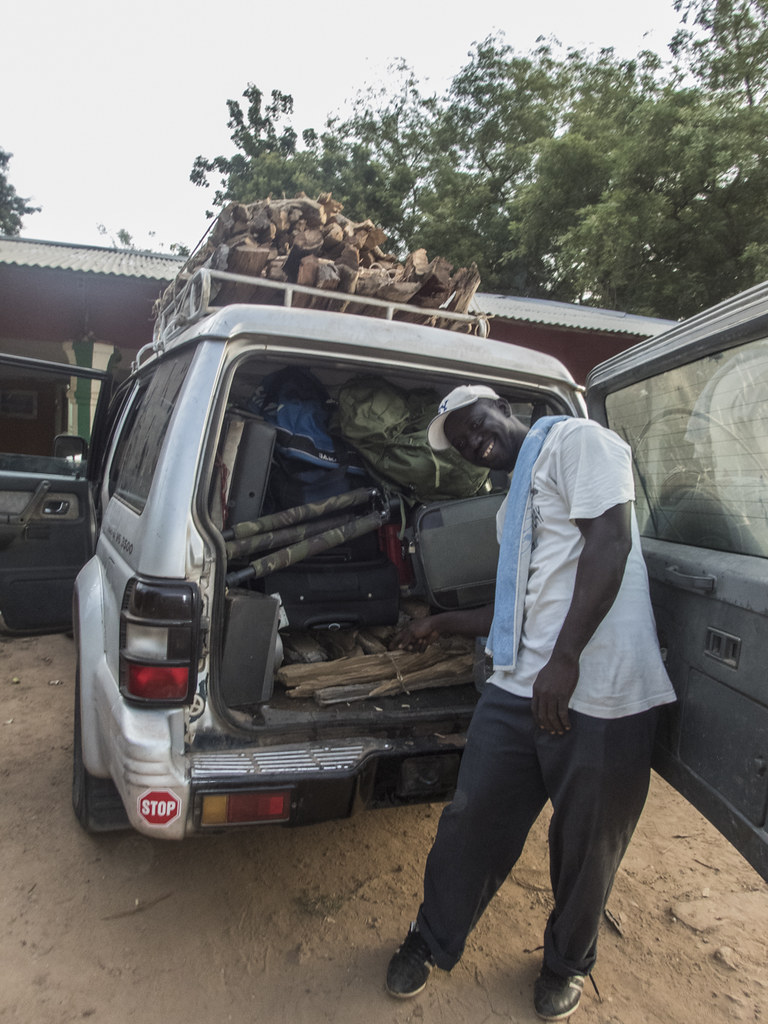 Once again we stopped immediately outside the gates, no Bush-shrike but the pigeon was still there.
Once again we stopped immediately outside the gates, no Bush-shrike but the pigeon was still there.
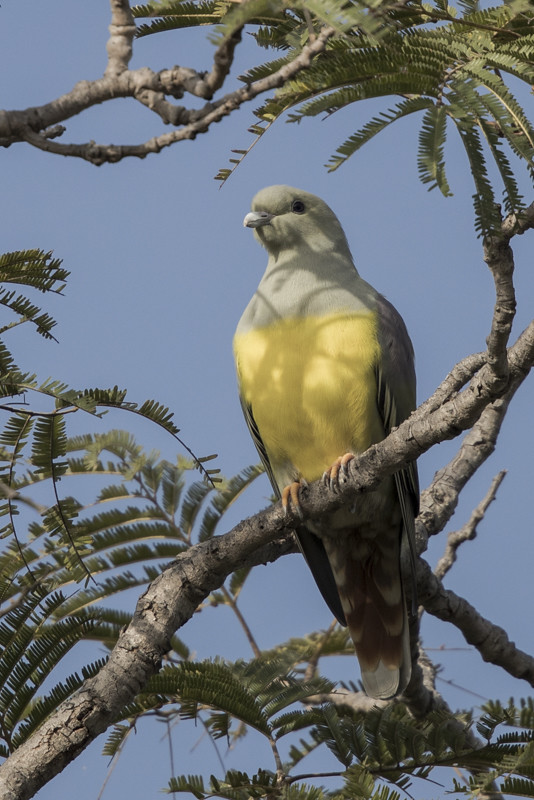 and in a moment of Deja Vu a Double-spurred Francolin appeared at the side of the road before running across.
and in a moment of Deja Vu a Double-spurred Francolin appeared at the side of the road before running across.
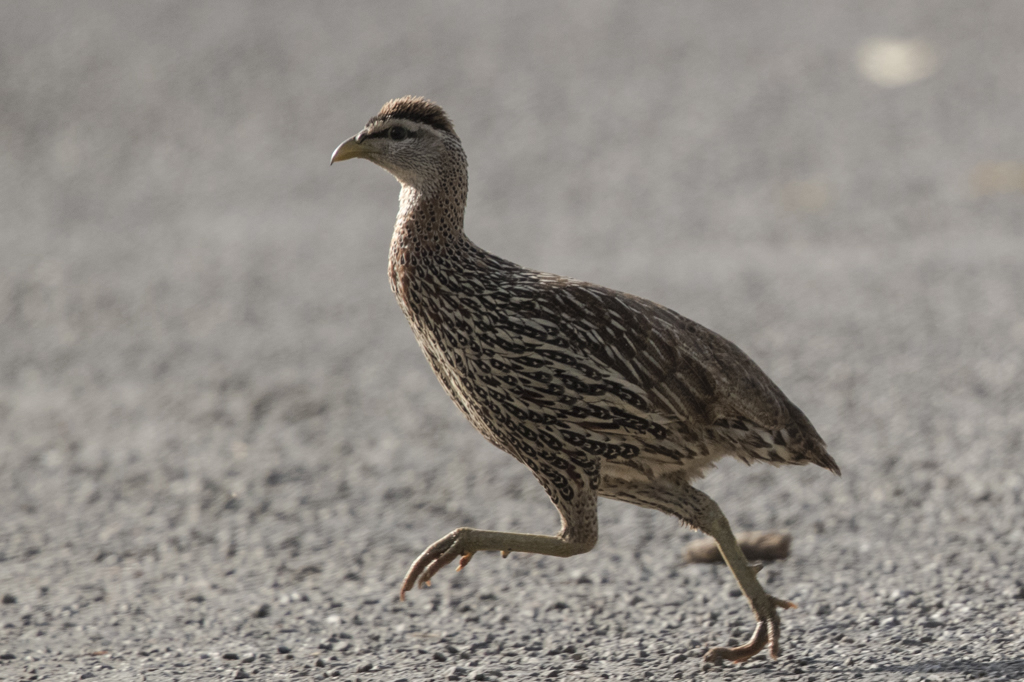 Exactly the same as 2 years previously only I got better snaps this time around!
During the course of the journey a huge sack of charcoal was added to the roof and a few of watermelons joined us in the cab. Room in the back was a bit cramped as we had to make room for my camera bag now the back was full. Still the watermelons travelled in comfort and arrived back in pristine condition. I'm not sure the savings on the purchases were greater than the increased fuel consumption of a thirsty V6 petrol Pajero but that wasn't our concern.
From memory other than shopping stops we only made one birding stop other than the regulation road blocks. At one the soldier on duty questioned my tripod that had been in open view in the back of the vehicle. You'll notice from the picture above it has camouflaged legs. I bought it with them on and they do make it more comfortable to carry, especially when it's cold.
The soldier demanded our driver get it out for examination. He'd no idea what it was and wanted to know why it was in the back of the car and camouflaged. Fair do's the driver wasn't intimidated by the gun the soldier was toting and gave back as good as he got telling him it wasn't his fault that his guests had arrived at the international airport with it.
Without further ado we were allowed to carry on but for the one and only time on the journey at one of the police checks a subtle request for money resulted in a note or two exchanging hands very surreptitiously. Our guide admitted after he'd passed over some cash, he said the policeman was an old friend and former boss.
Some friend!
Anyway, we were heading to Farasuto Woods and a meeting with our contact there, the Owl Man. A phone call had confirmed the Owls were present and had been showing well.
I think you have to take much of what you are told with a pinch of salt and in fact it's best not to have any expectations at all!
Owl can be extremely difficult to see never mind photograph. The local guides amaze me that they can see them so easily when sometimes it takes me an age to spot what they are trying to show me.
First species was the Greyish Eagle Owl. Last time it had been a bit of a 'mare.
Exactly the same as 2 years previously only I got better snaps this time around!
During the course of the journey a huge sack of charcoal was added to the roof and a few of watermelons joined us in the cab. Room in the back was a bit cramped as we had to make room for my camera bag now the back was full. Still the watermelons travelled in comfort and arrived back in pristine condition. I'm not sure the savings on the purchases were greater than the increased fuel consumption of a thirsty V6 petrol Pajero but that wasn't our concern.
From memory other than shopping stops we only made one birding stop other than the regulation road blocks. At one the soldier on duty questioned my tripod that had been in open view in the back of the vehicle. You'll notice from the picture above it has camouflaged legs. I bought it with them on and they do make it more comfortable to carry, especially when it's cold.
The soldier demanded our driver get it out for examination. He'd no idea what it was and wanted to know why it was in the back of the car and camouflaged. Fair do's the driver wasn't intimidated by the gun the soldier was toting and gave back as good as he got telling him it wasn't his fault that his guests had arrived at the international airport with it.
Without further ado we were allowed to carry on but for the one and only time on the journey at one of the police checks a subtle request for money resulted in a note or two exchanging hands very surreptitiously. Our guide admitted after he'd passed over some cash, he said the policeman was an old friend and former boss.
Some friend!
Anyway, we were heading to Farasuto Woods and a meeting with our contact there, the Owl Man. A phone call had confirmed the Owls were present and had been showing well.
I think you have to take much of what you are told with a pinch of salt and in fact it's best not to have any expectations at all!
Owl can be extremely difficult to see never mind photograph. The local guides amaze me that they can see them so easily when sometimes it takes me an age to spot what they are trying to show me.
First species was the Greyish Eagle Owl. Last time it had been a bit of a 'mare.
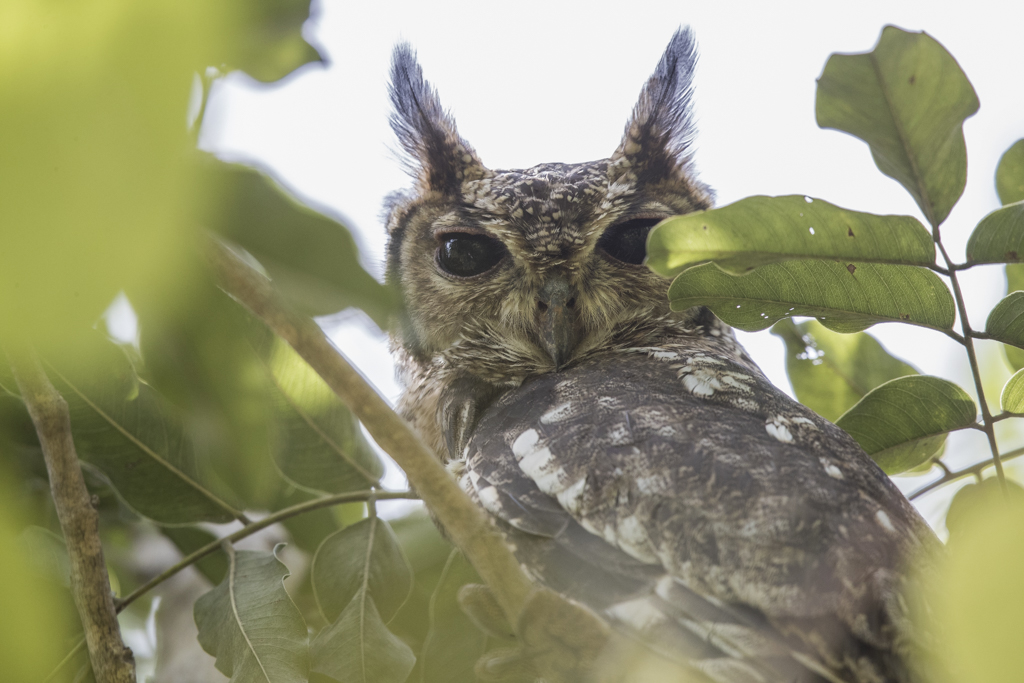 This time I think I did marginally better. That shot might look as if the bird is on the same level as me but it isn't. It's directly above me looking down.
Attempts to get in to a similar position with the Northern White-faced Owl were no better than the one taken with the branch of a tree across it's middle!
This time I think I did marginally better. That shot might look as if the bird is on the same level as me but it isn't. It's directly above me looking down.
Attempts to get in to a similar position with the Northern White-faced Owl were no better than the one taken with the branch of a tree across it's middle!
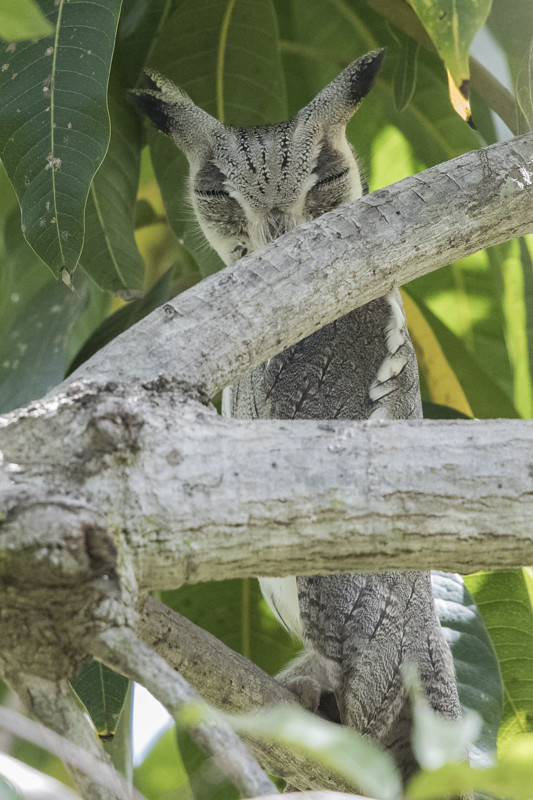 But the last one was the worst of the lot!
The African Wood Owl was a first for me and when we arrived at the tree the bird was sitting nicely in full display. I spotted it straight away for a change but our guide decided to try the new toy Alan had bought him as a gift. A laser pointer.
The minute he turned it on, the Owl moved and that was without pointing it in the Owls direction.
Damn! Co-incidence ? Maybe but we know how sensitive the Owl's eyes are to light. They need to be used with care and consideration. Another example will follow in a later episode of this blog!
As for the Wood Owl, well despite all the efforts of the guides to find a better vantage point the best photo I could manage was this one.
But the last one was the worst of the lot!
The African Wood Owl was a first for me and when we arrived at the tree the bird was sitting nicely in full display. I spotted it straight away for a change but our guide decided to try the new toy Alan had bought him as a gift. A laser pointer.
The minute he turned it on, the Owl moved and that was without pointing it in the Owls direction.
Damn! Co-incidence ? Maybe but we know how sensitive the Owl's eyes are to light. They need to be used with care and consideration. Another example will follow in a later episode of this blog!
As for the Wood Owl, well despite all the efforts of the guides to find a better vantage point the best photo I could manage was this one.
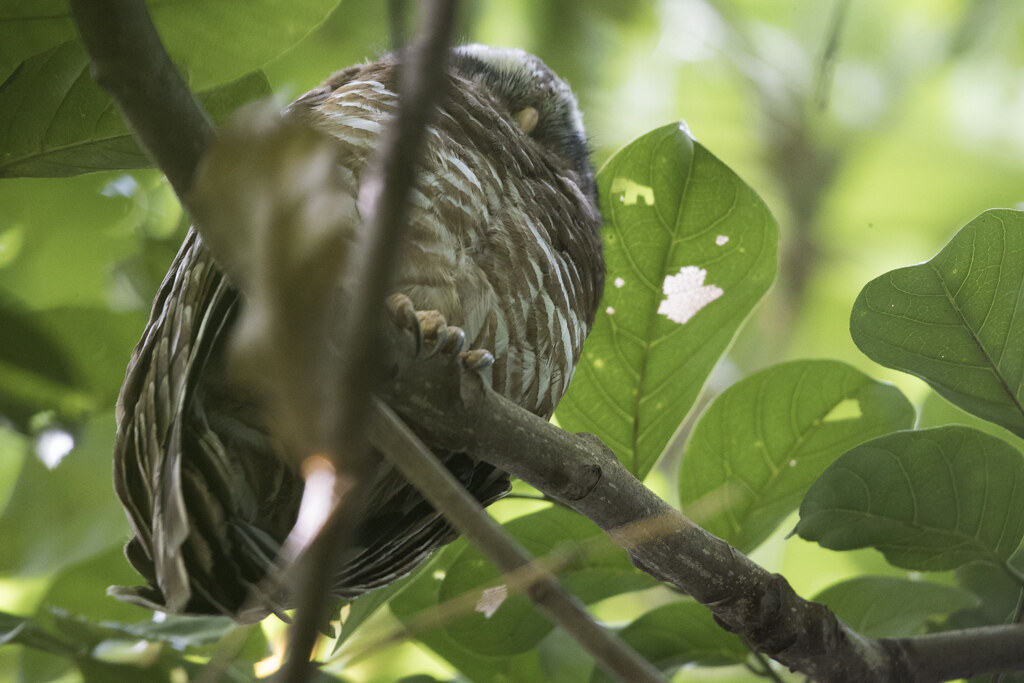 Looks more like a wasp's nest than a bird!
Never mind, that's the way it goes sometimes. Out of the woods we did get lucky and I got my first ever shots of a Gabar Goshawk so that was an unexpected bonus.
Looks more like a wasp's nest than a bird!
Never mind, that's the way it goes sometimes. Out of the woods we did get lucky and I got my first ever shots of a Gabar Goshawk so that was an unexpected bonus.
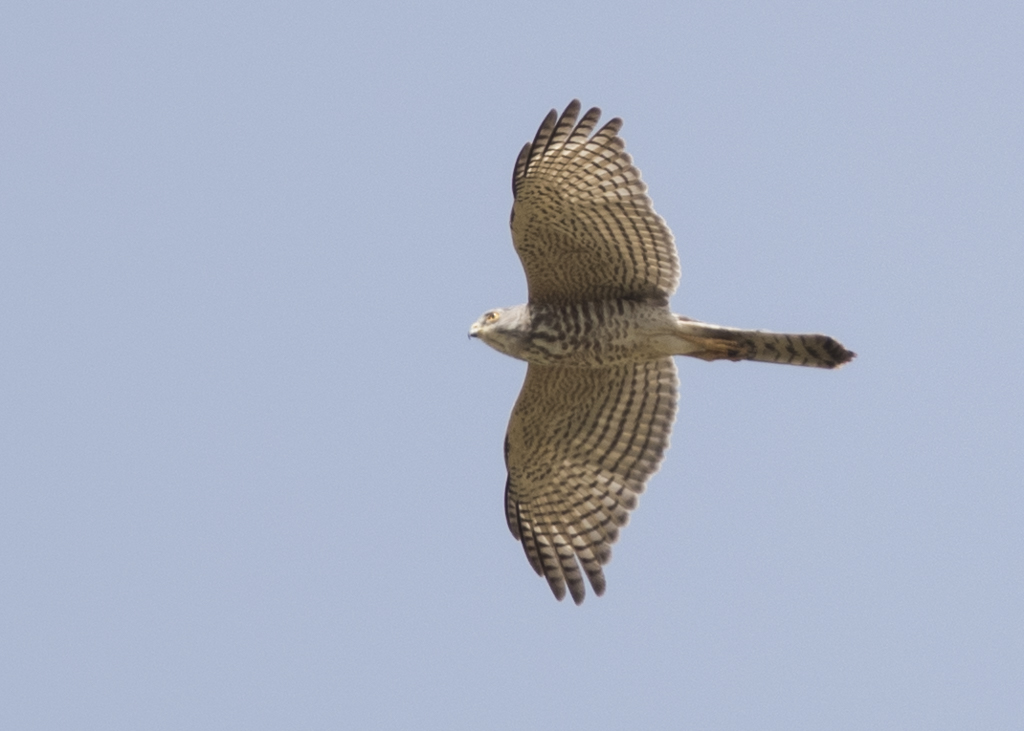 After this we were happy to get back to the hotel where we arrived at mid-afternoon.
After this we were happy to get back to the hotel where we arrived at mid-afternoon.
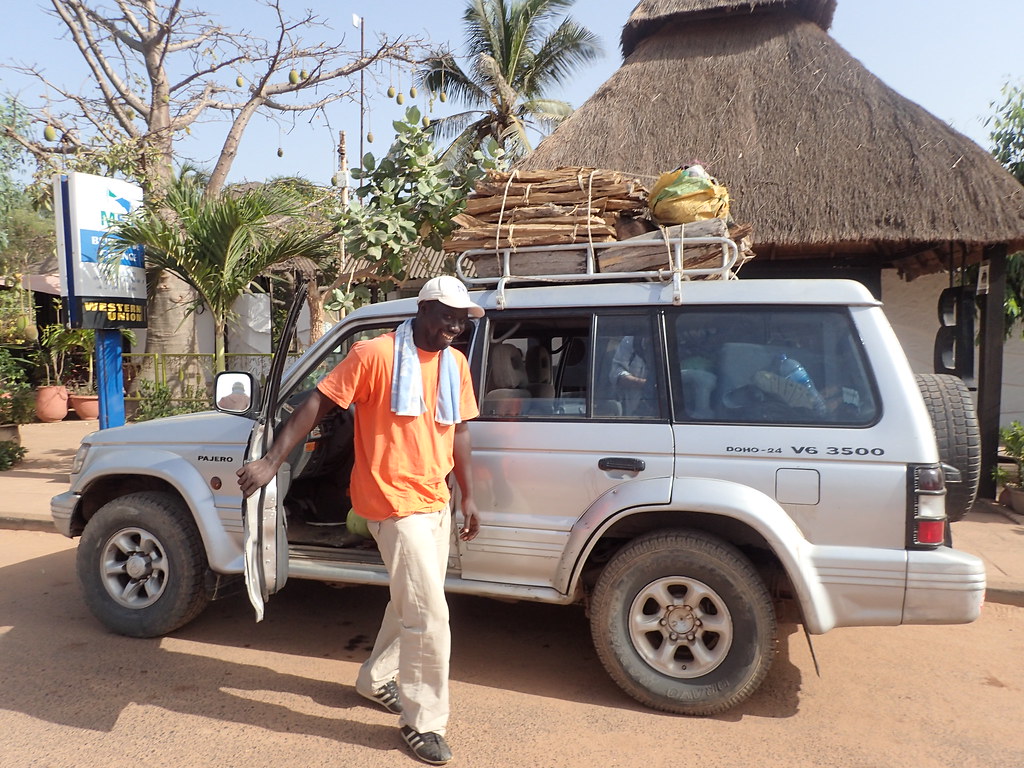 Yes, there was even a watermelon stored under the drivers legs!!!
TBC.
Yes, there was even a watermelon stored under the drivers legs!!!
TBC.
The stay at Baobalong was all over too quickly, with hindsight and with 5 nights to arrange I would have stayed there for 3 and just 2 at Tendaba. If there is a next time I will probably do it that way. Some choose to cut out Tendaba altogether and if you stick to the south bank road you can do it with ease in a day as you don't need to catch a ferry, the road is good and there is little traffic. You would then of course have to make the return journey from Baobolong to Farafenni if you wanted to catch up with the Egyptian Plover and Hornbill site and there is the rub...it's as much distance doing that as the whole route to the coast.
Anyway, we had a second boat trip out of Tendaba to look forward to in the evening and there were a couple of places to visit on the way there too. We took the easy route over the bridge to leave the island.
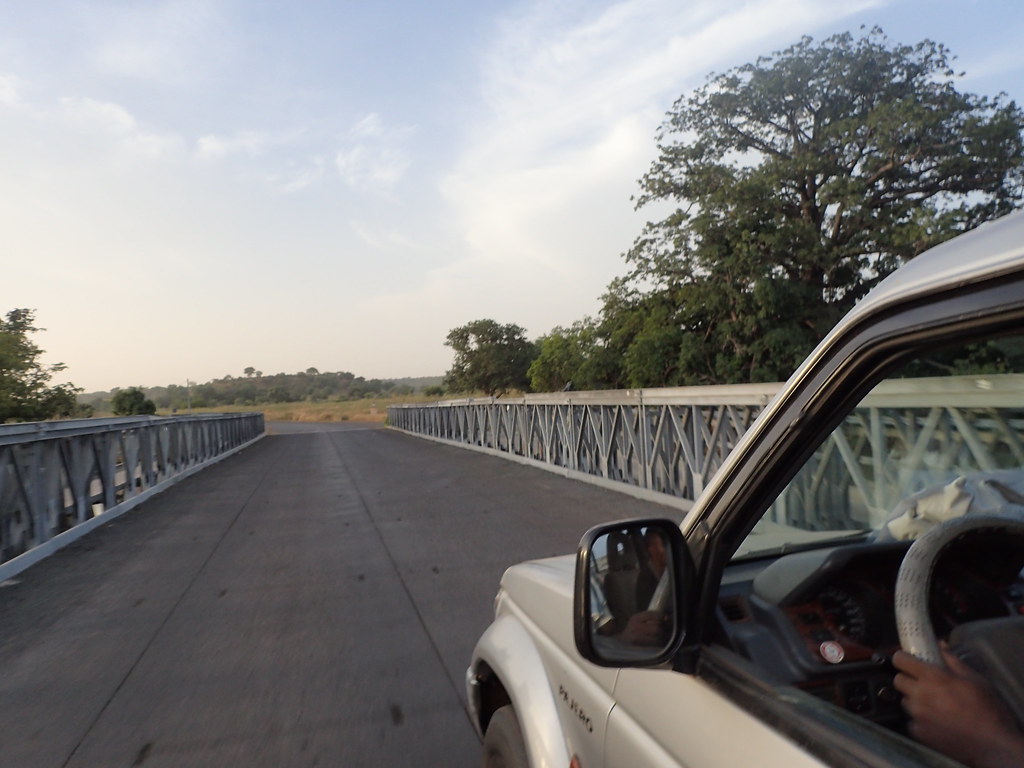 First stop was to a Marabou Stork nesting site,
First stop was to a Marabou Stork nesting site,
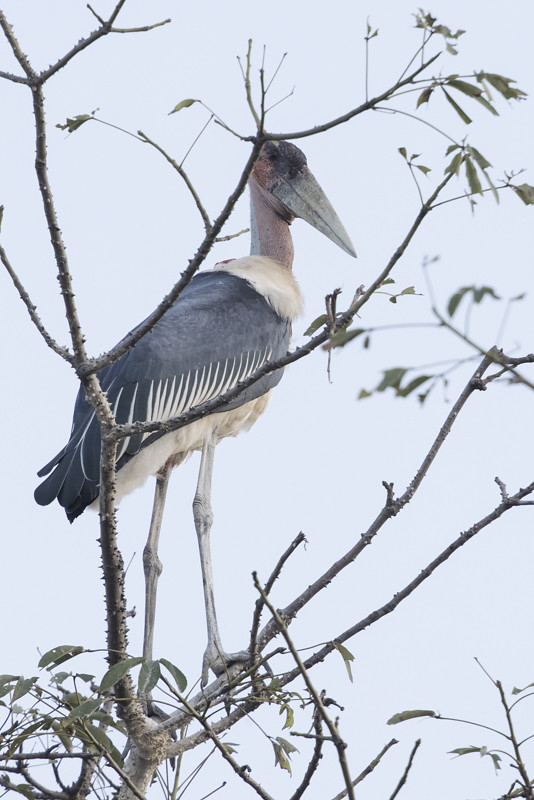 The views were obscured, the surrounding grassland difficult, the sun was in the wrong direction but the worst bit we had become surrounded by children!
The views were obscured, the surrounding grassland difficult, the sun was in the wrong direction but the worst bit we had become surrounded by children!
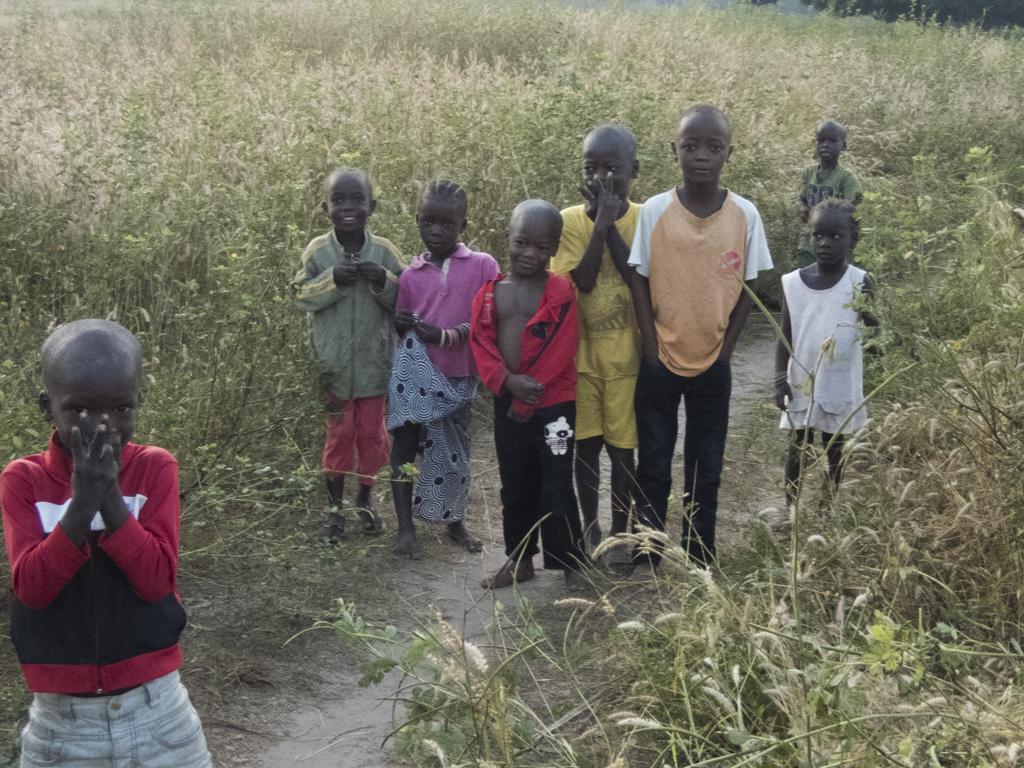 Those are just a few of them! In many places you are a star attraction, obviously tourists and with some incredibly strange long lenses, tripods and cameras. You can't blame them really, I'd have done the same in their position.
We moved on again, this time driving through a crowded, busy market town. Sharing narrow passageways with pedestrians as well as donkey drawn carts is challenging for any driver, one of several reasons the the advice not to try self drive.
Those are just a few of them! In many places you are a star attraction, obviously tourists and with some incredibly strange long lenses, tripods and cameras. You can't blame them really, I'd have done the same in their position.
We moved on again, this time driving through a crowded, busy market town. Sharing narrow passageways with pedestrians as well as donkey drawn carts is challenging for any driver, one of several reasons the the advice not to try self drive.
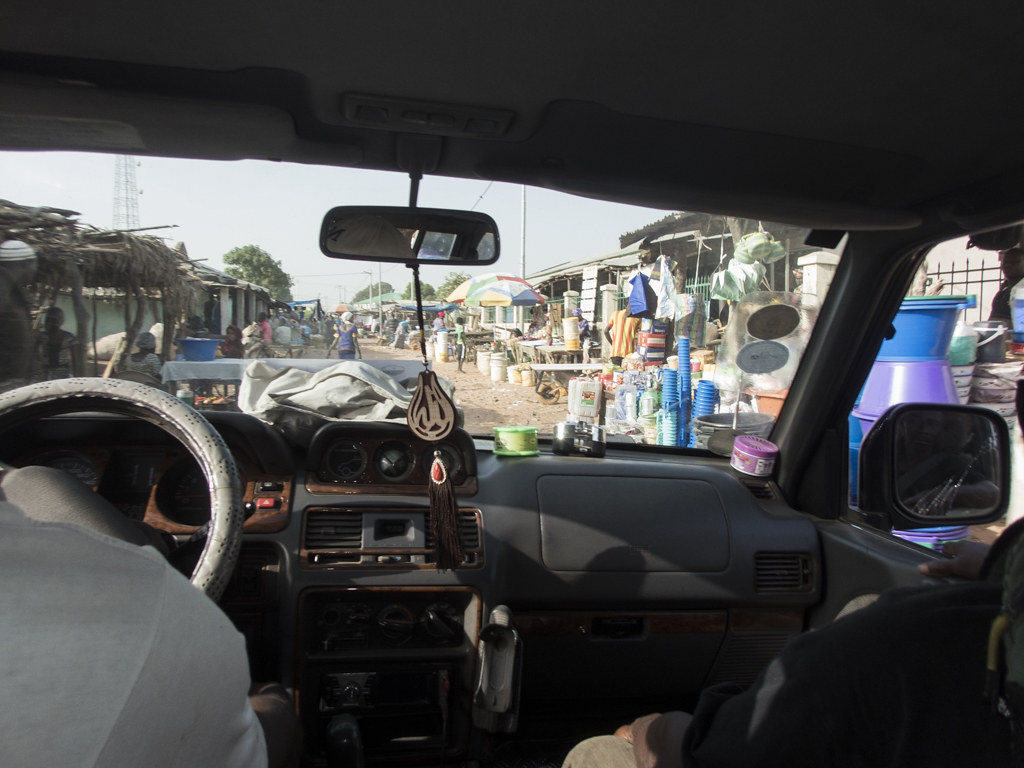 Parking the car we walked to a large tree. More Verraux's Eagle Owls and showing oh so well too.
Parking the car we walked to a large tree. More Verraux's Eagle Owls and showing oh so well too.
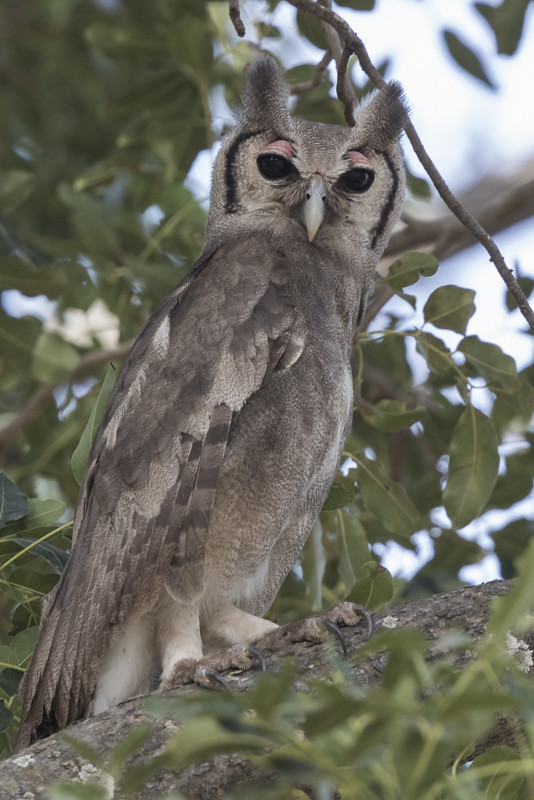 I was pleased that Alan would get a photo opportunity after all.
I was pleased that Alan would get a photo opportunity after all.
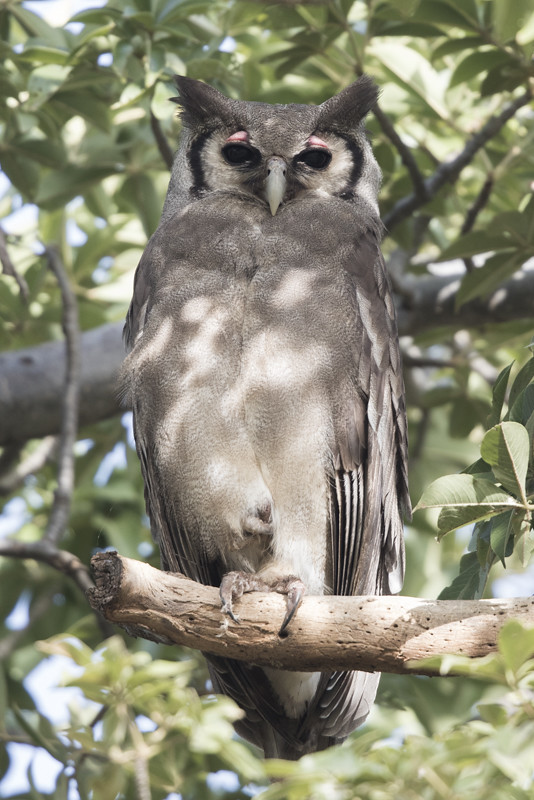 Moving on we were soon in an area rice fields and once again, Black Coucal was the target. Once again we failed to locate one but we did come across a Black-faced Quailfinch which was a good find.
Moving on we were soon in an area rice fields and once again, Black Coucal was the target. Once again we failed to locate one but we did come across a Black-faced Quailfinch which was a good find.
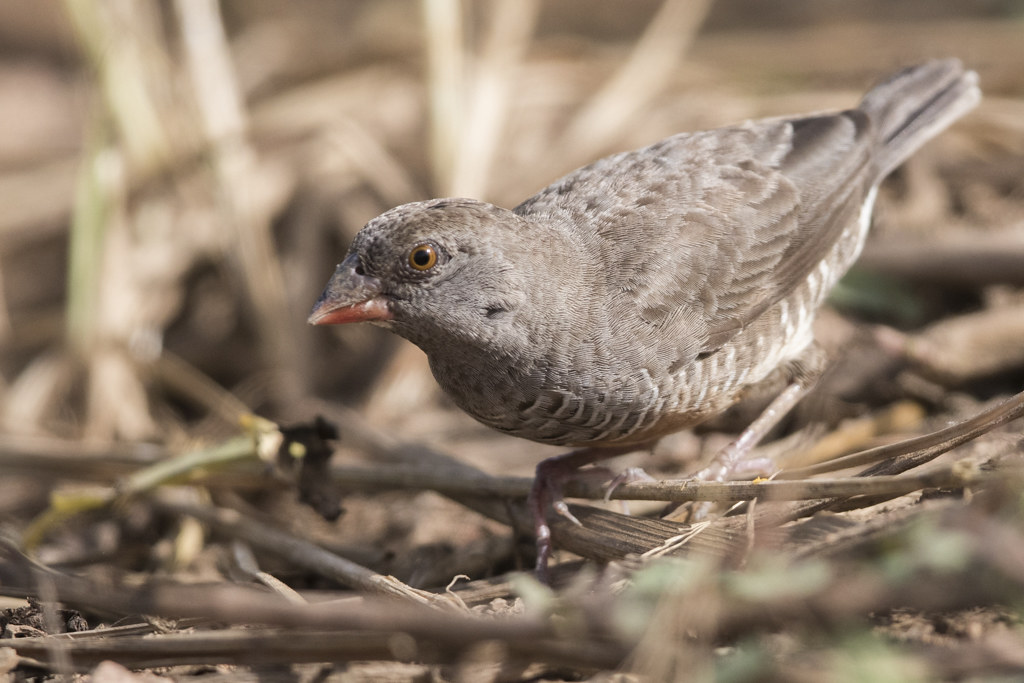 It was getting hot, very hot. With no cover whatsoever we were glad to abandon our search after a good hour.
It was getting hot, very hot. With no cover whatsoever we were glad to abandon our search after a good hour.
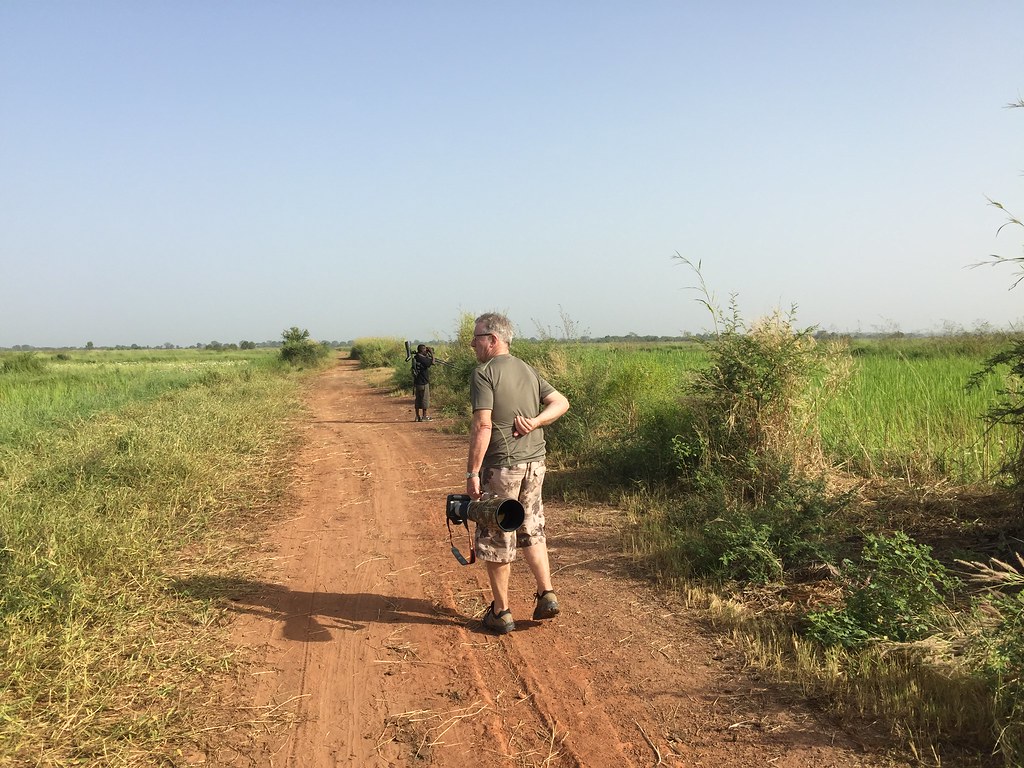 That's me scratching my mossy bites! The Gambia is a fairly high risk zone when it comes to malaria, so those minute insects are Africa's biggest killer . Taking anti-malarials is a must.
What we did find though was evidence of one of the few mammals you might come across in The Gambia.
That's me scratching my mossy bites! The Gambia is a fairly high risk zone when it comes to malaria, so those minute insects are Africa's biggest killer . Taking anti-malarials is a must.
What we did find though was evidence of one of the few mammals you might come across in The Gambia.
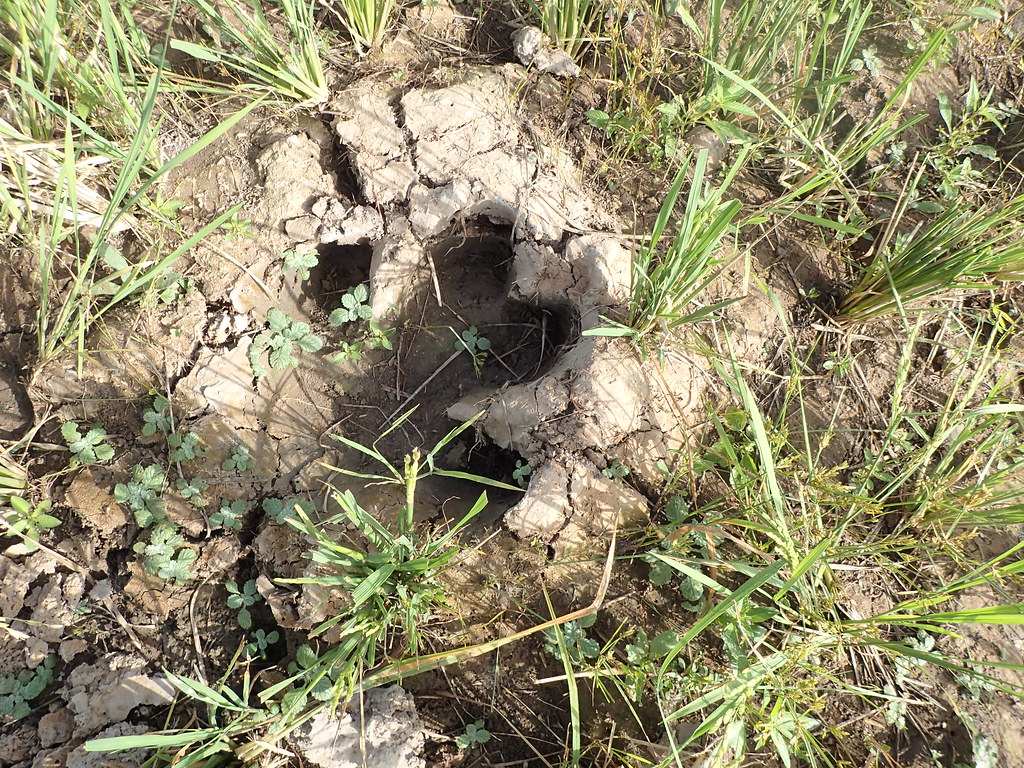 It's Africa's deadliest mammal apparently with more fatalities caused than any other species.
You don't try to shoo it away if you find it munching your crops, you have to accept the devastation I guess.
It's Africa's deadliest mammal apparently with more fatalities caused than any other species.
You don't try to shoo it away if you find it munching your crops, you have to accept the devastation I guess.
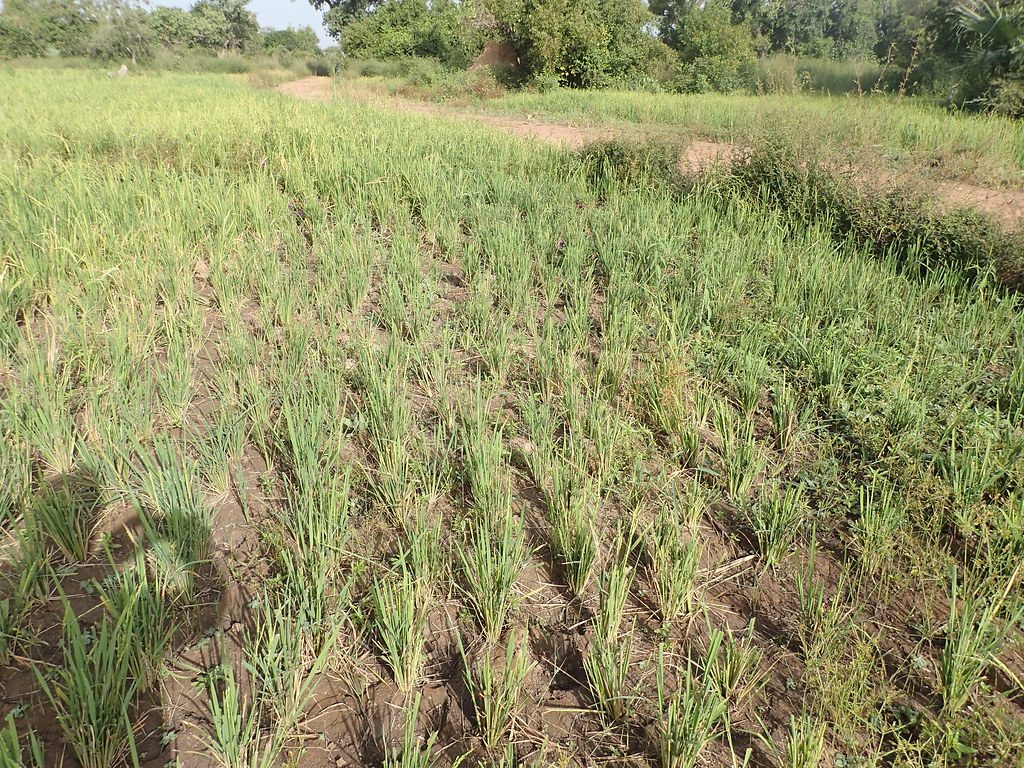 Depending on which way you look at it and how close you were at the time, we fortunately didn't see a Hippo in the flesh on our walk about.
Next stop was when our driver spotted some Yellow-billed Oxpeckers on some roadside cattle.
Did we want to stop?
You bet we did!
One of my favourite species to photograph if you get lucky with a pose.
Depending on which way you look at it and how close you were at the time, we fortunately didn't see a Hippo in the flesh on our walk about.
Next stop was when our driver spotted some Yellow-billed Oxpeckers on some roadside cattle.
Did we want to stop?
You bet we did!
One of my favourite species to photograph if you get lucky with a pose.
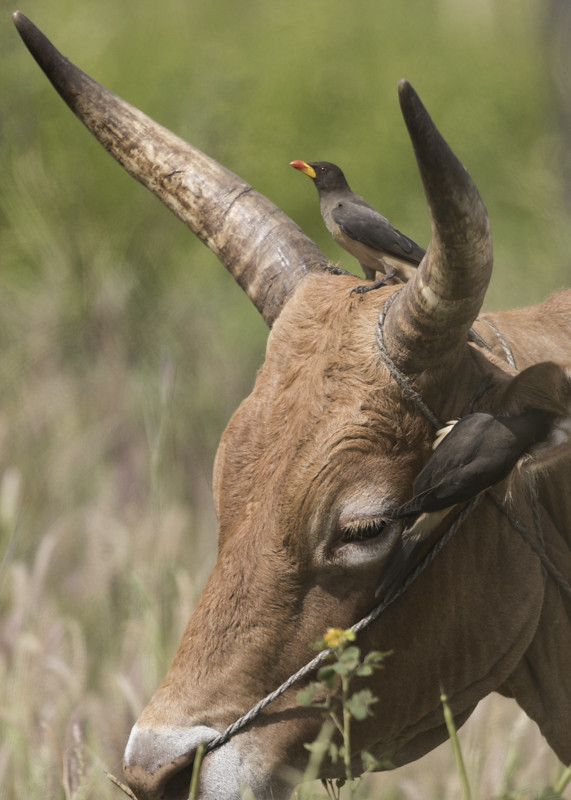 That's the nearest I got , it wasn't to be my lucky day.
That's the nearest I got , it wasn't to be my lucky day.
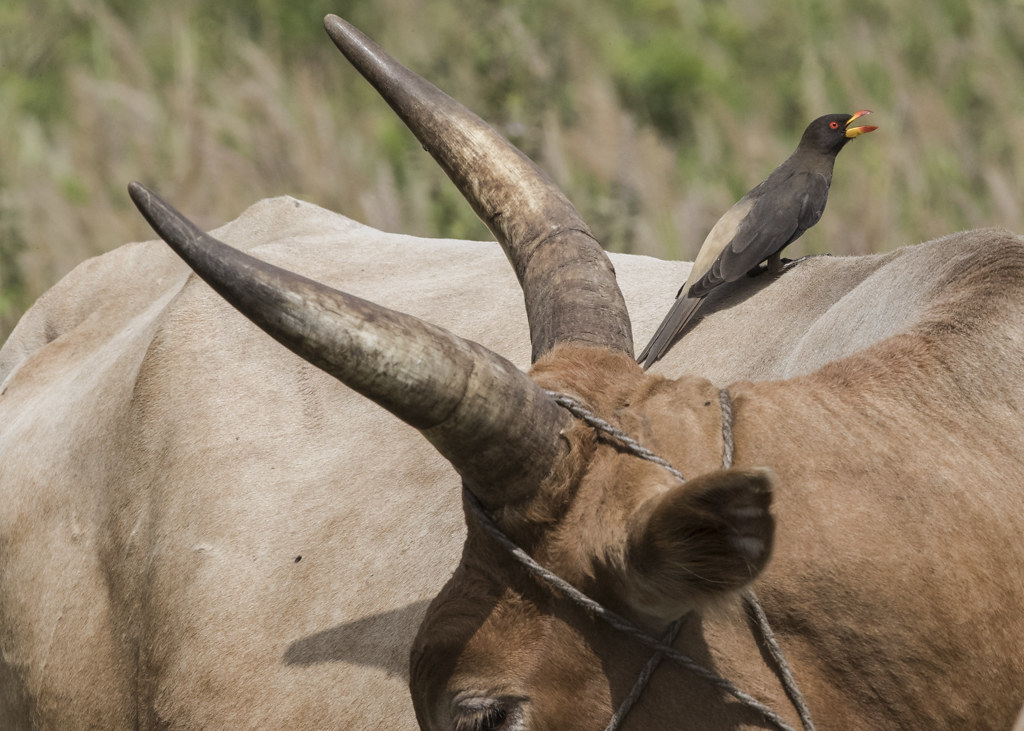 Neither cow nor bird were prepared to co-operate with the latter flying off to find a new friend to feed on.
We were pleased to have stopped though as while we were there a Long-crested Eagle flew in to view.
Neither cow nor bird were prepared to co-operate with the latter flying off to find a new friend to feed on.
We were pleased to have stopped though as while we were there a Long-crested Eagle flew in to view.
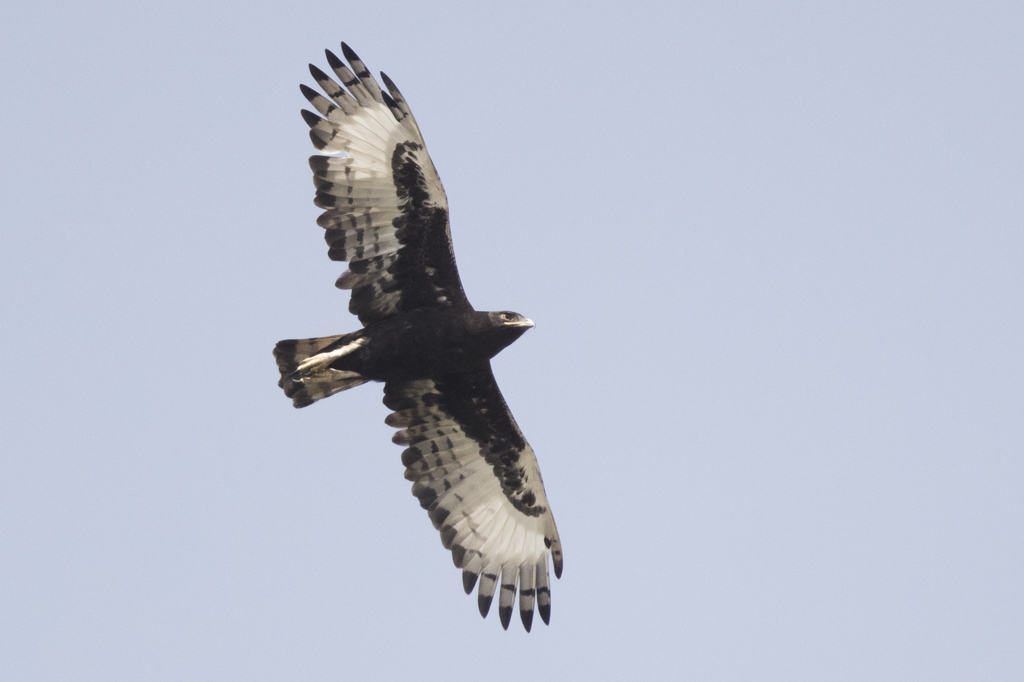 Then another big bird appeared to land in a distant tree.
"African Harrier Hawk!" said our guide.
Alan wanted a view through the telescope.
What he found was a magnificent Martial Eagle. The view through the 'scope was fabulous but we had to try and capture it on camera.
We set off through the undergrowth once again, fighting our way through the usual long grass and barbed bushes. The Eagle flew as we approached but headed to a distant tree that was within the possibilities of reaching. We carried on.
Then we saw it!
Then another big bird appeared to land in a distant tree.
"African Harrier Hawk!" said our guide.
Alan wanted a view through the telescope.
What he found was a magnificent Martial Eagle. The view through the 'scope was fabulous but we had to try and capture it on camera.
We set off through the undergrowth once again, fighting our way through the usual long grass and barbed bushes. The Eagle flew as we approached but headed to a distant tree that was within the possibilities of reaching. We carried on.
Then we saw it!
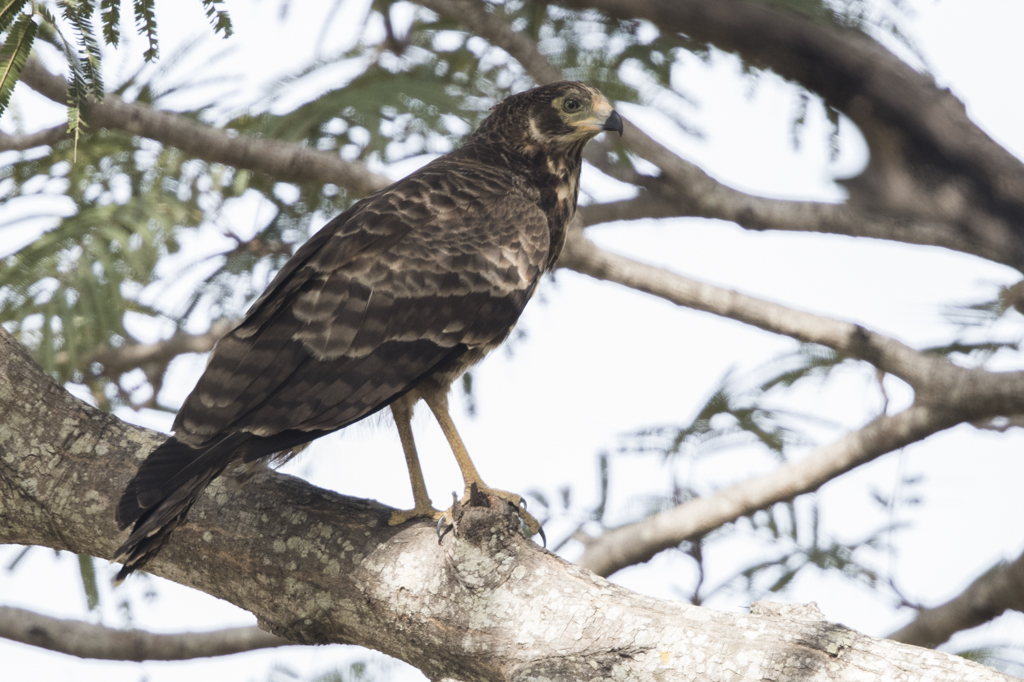 Not the Eagle unfortunately but a juvenile African Harrier Hawk which is what our guide had probably seen in the first place.
Not the Eagle unfortunately but a juvenile African Harrier Hawk which is what our guide had probably seen in the first place.
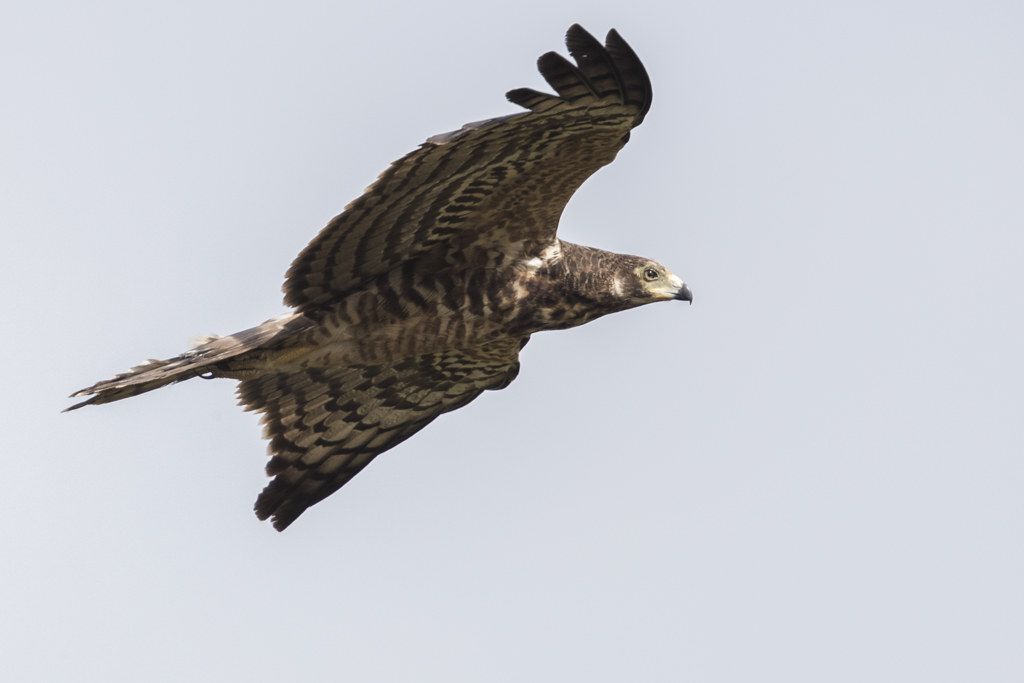 It didn't hang around long and neither did the Martial Eagle. The latter was destined to be nothing more than a memory, but what a memory. In Alan's opinion it was the bird of the trip and I wouldn't dispute that.
There was one more notable site to visit en route to Tendaba and that was a place noted for Spotted Thick-knee. We found them without too much problem but they too were camera shy. Bigger and longer legged than previous Thick-knees I have seen they couldn't half run fast through the bushy scrub. I managed no more than a record shot as the two we found took flight when I didn't expect it.
It didn't hang around long and neither did the Martial Eagle. The latter was destined to be nothing more than a memory, but what a memory. In Alan's opinion it was the bird of the trip and I wouldn't dispute that.
There was one more notable site to visit en route to Tendaba and that was a place noted for Spotted Thick-knee. We found them without too much problem but they too were camera shy. Bigger and longer legged than previous Thick-knees I have seen they couldn't half run fast through the bushy scrub. I managed no more than a record shot as the two we found took flight when I didn't expect it.
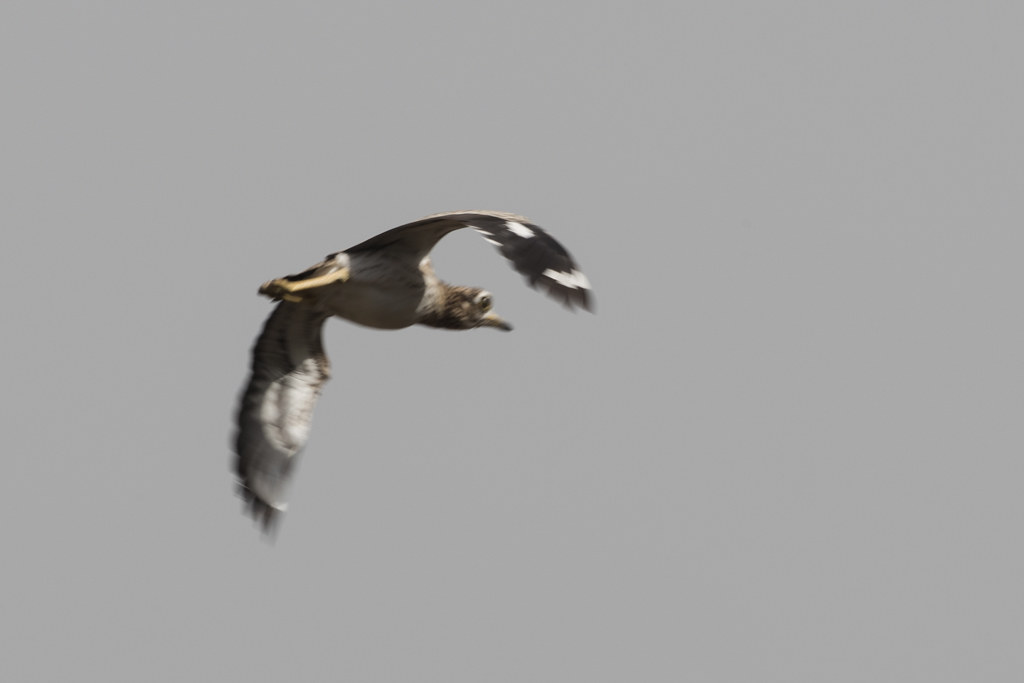 Won't win any prizes with that one!
Back at Tendaba we didn't have long to wait before we set off on our boat trip. This time there were just five on the boat and our views were unobstructed.
The last time we had been at Tendaba, the evening boat trip had been far better than the morning one. Regrettably that wasn't the case this time around. There was an even bigger lack of birds than a couple of days previously.
By far the greatest numbers were African Darters.
Won't win any prizes with that one!
Back at Tendaba we didn't have long to wait before we set off on our boat trip. This time there were just five on the boat and our views were unobstructed.
The last time we had been at Tendaba, the evening boat trip had been far better than the morning one. Regrettably that wasn't the case this time around. There was an even bigger lack of birds than a couple of days previously.
By far the greatest numbers were African Darters.
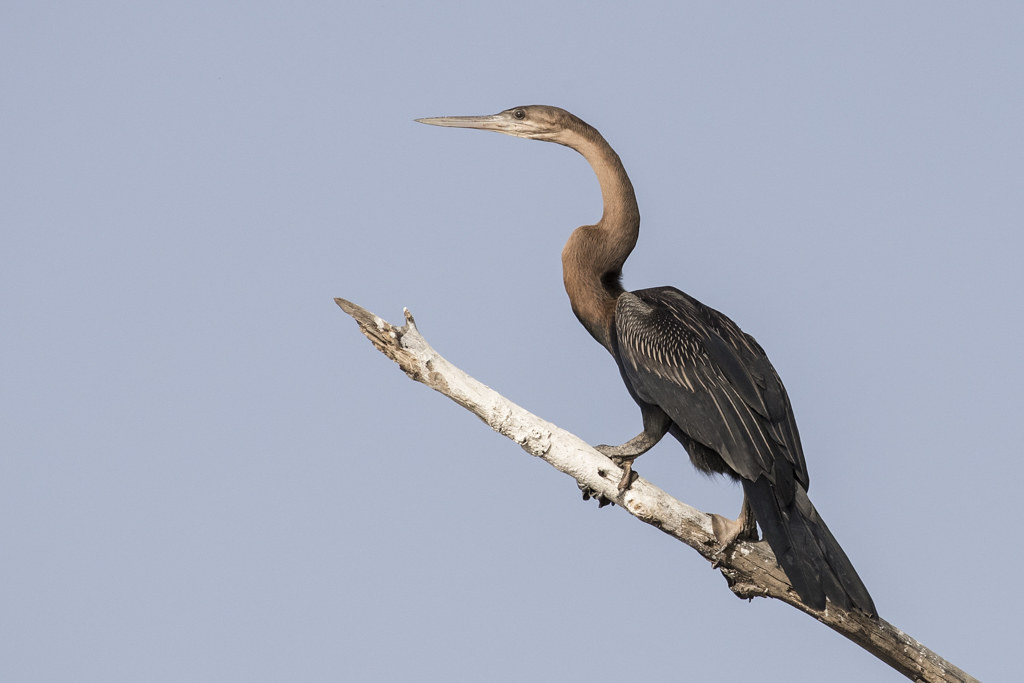 They look sleek when they are sat on a branch but, unusually sighted on the muddy bank, not quite so!
They look sleek when they are sat on a branch but, unusually sighted on the muddy bank, not quite so!
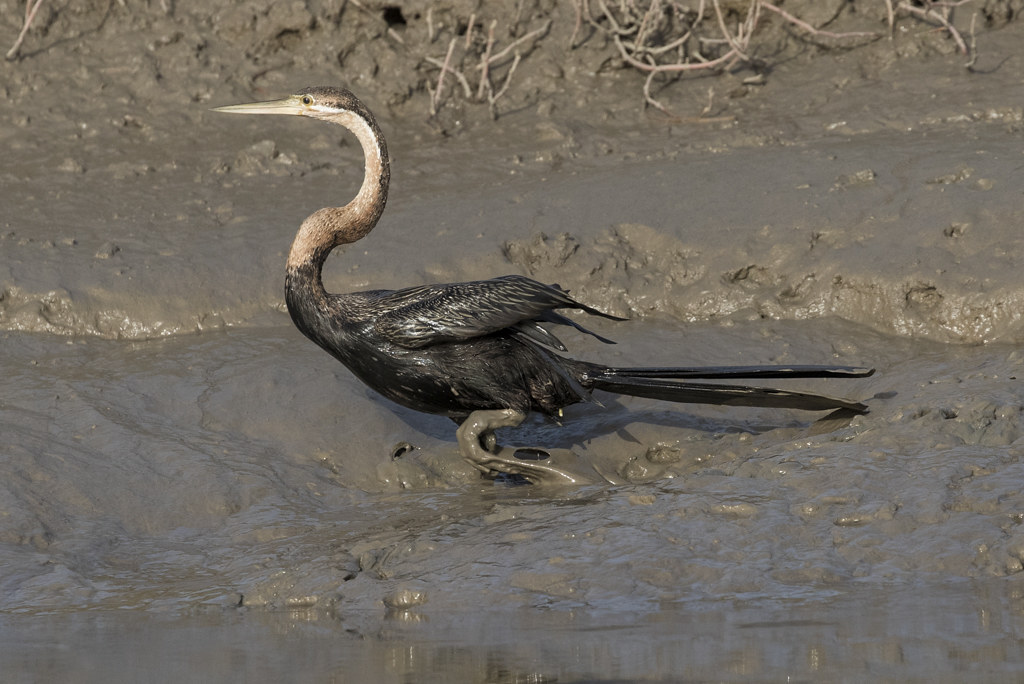 They are pretty ungainly when they drop like a stone in to the water too, but once in they are superbly designed for underwater hunting.
On this trip there wasn't a Cormorant to be seen, the Storks had all left too, it was very disappointing.
One of the problems was it was low tide, yes the river drops a few metres even this far up stream. Many of the back channels were too shallow for our boat. No way could we go the route that took in the view of the distant Martial Eagle so hopes of one sat outside the nest were gone too.
Our biggest hope was left in a better sighting of the White-backed Night Herons. Very skittish this time they vanished as soon as we approached and we told our boatman to leave them alone as we didn't want to be responsible for the disturbance.
Probably our best views were of a displaying Blue-breated Kingfisher
They are pretty ungainly when they drop like a stone in to the water too, but once in they are superbly designed for underwater hunting.
On this trip there wasn't a Cormorant to be seen, the Storks had all left too, it was very disappointing.
One of the problems was it was low tide, yes the river drops a few metres even this far up stream. Many of the back channels were too shallow for our boat. No way could we go the route that took in the view of the distant Martial Eagle so hopes of one sat outside the nest were gone too.
Our biggest hope was left in a better sighting of the White-backed Night Herons. Very skittish this time they vanished as soon as we approached and we told our boatman to leave them alone as we didn't want to be responsible for the disturbance.
Probably our best views were of a displaying Blue-breated Kingfisher
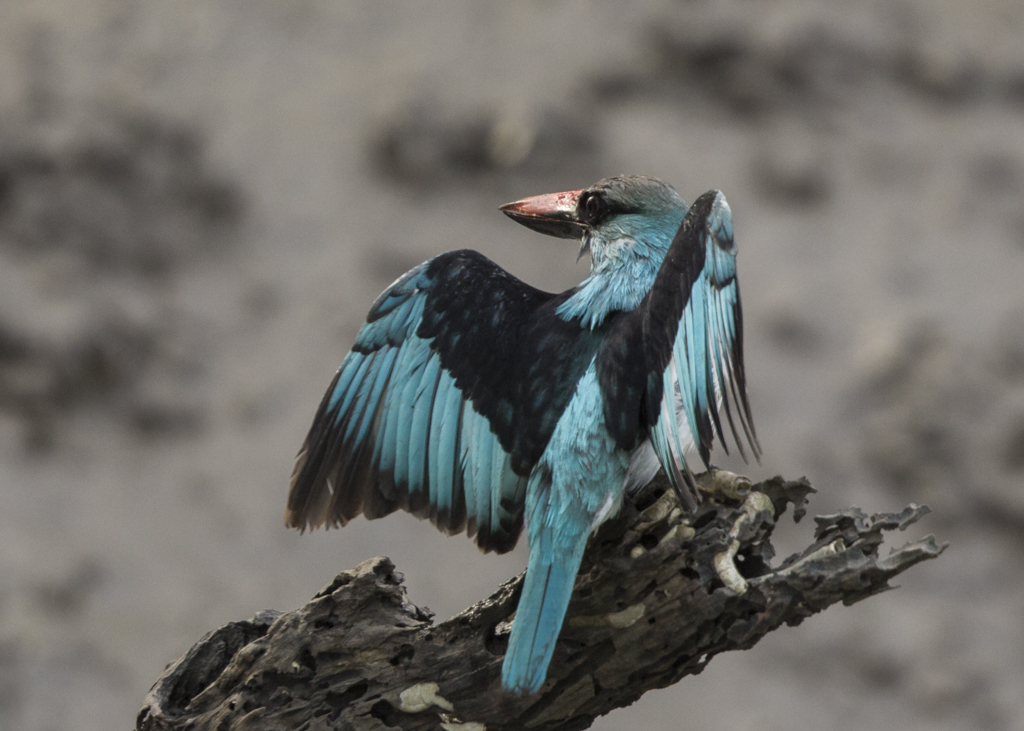
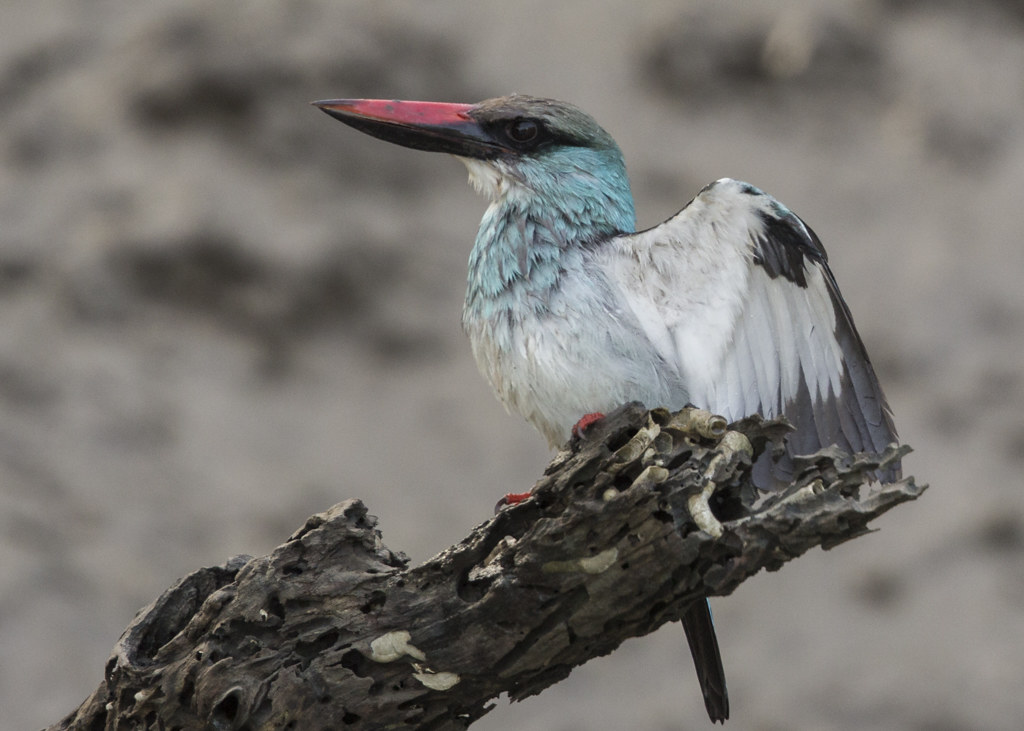 At first glance they are very similar to the Woodland Kingfishers too.
At first glance they are very similar to the Woodland Kingfishers too.
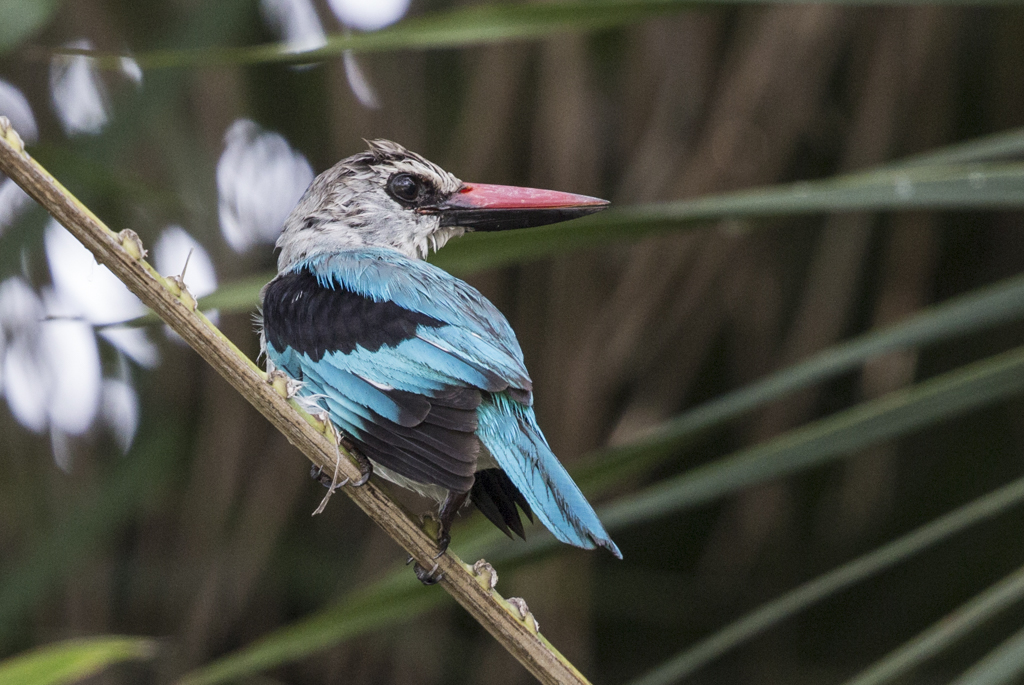 Similar size, similar colours but quite distinctive differences around the head.
Similar size, similar colours but quite distinctive differences around the head.
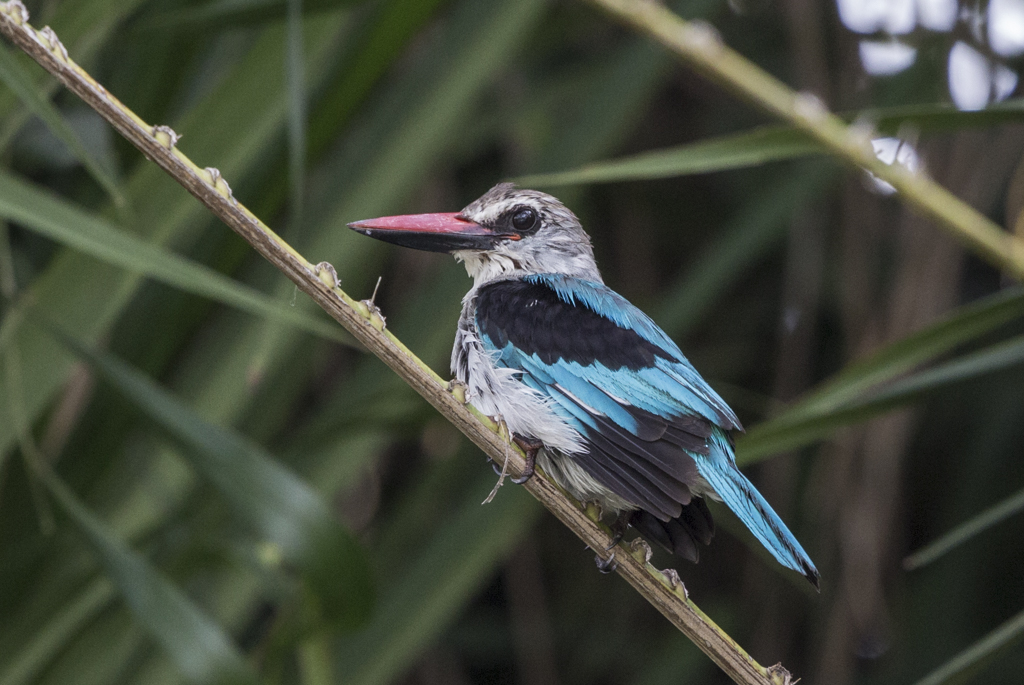 So that was it really, oh except for this monster, a West African Crocodile!
So that was it really, oh except for this monster, a West African Crocodile!
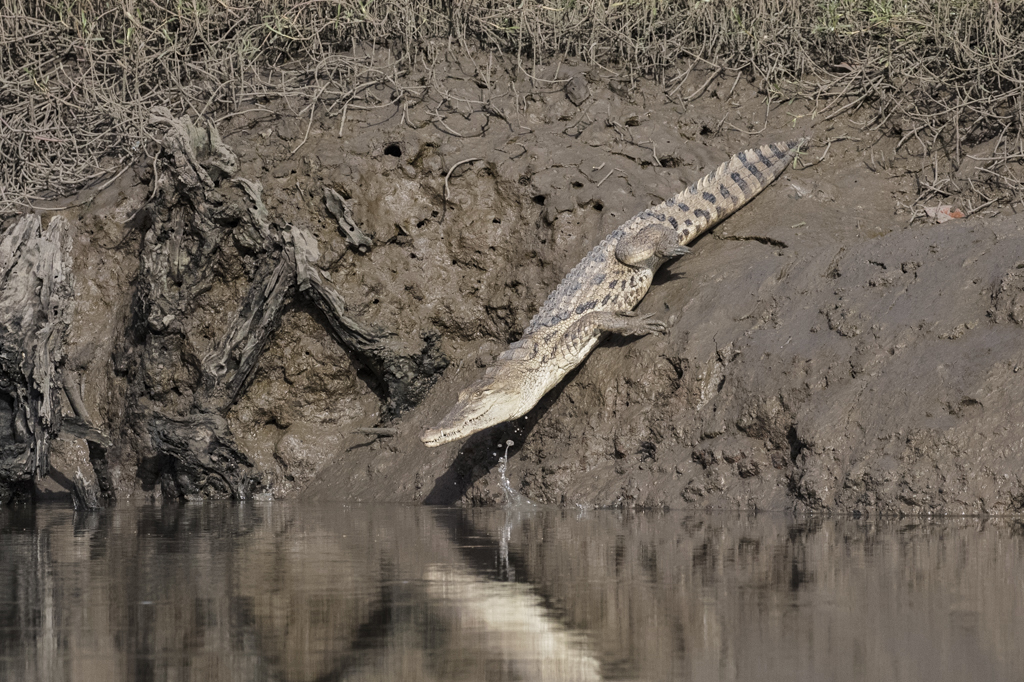 They can be skittish too, this one headed for the water long before we got very close.
It was back to Tendaba Camp then. The sun setting over the river was a stunning sight.
Alan tried to make me a saintly figure.
They can be skittish too, this one headed for the water long before we got very close.
It was back to Tendaba Camp then. The sun setting over the river was a stunning sight.
Alan tried to make me a saintly figure.
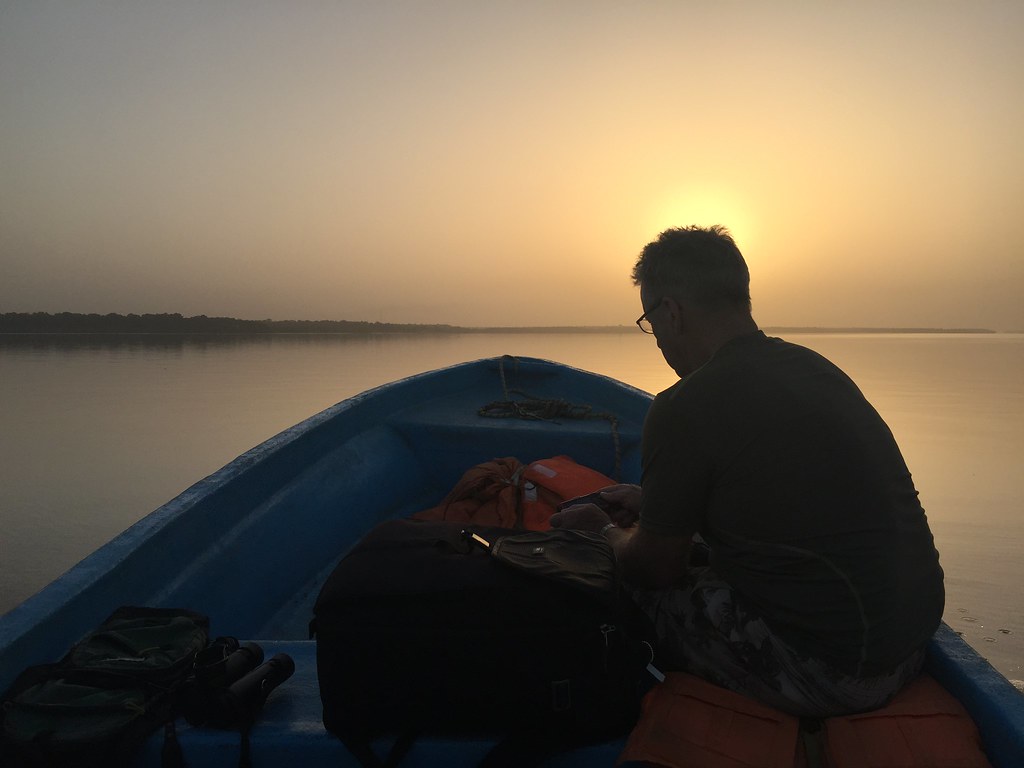 While I was trying for something a bit arty with the aid of a waterproof camera!
While I was trying for something a bit arty with the aid of a waterproof camera!
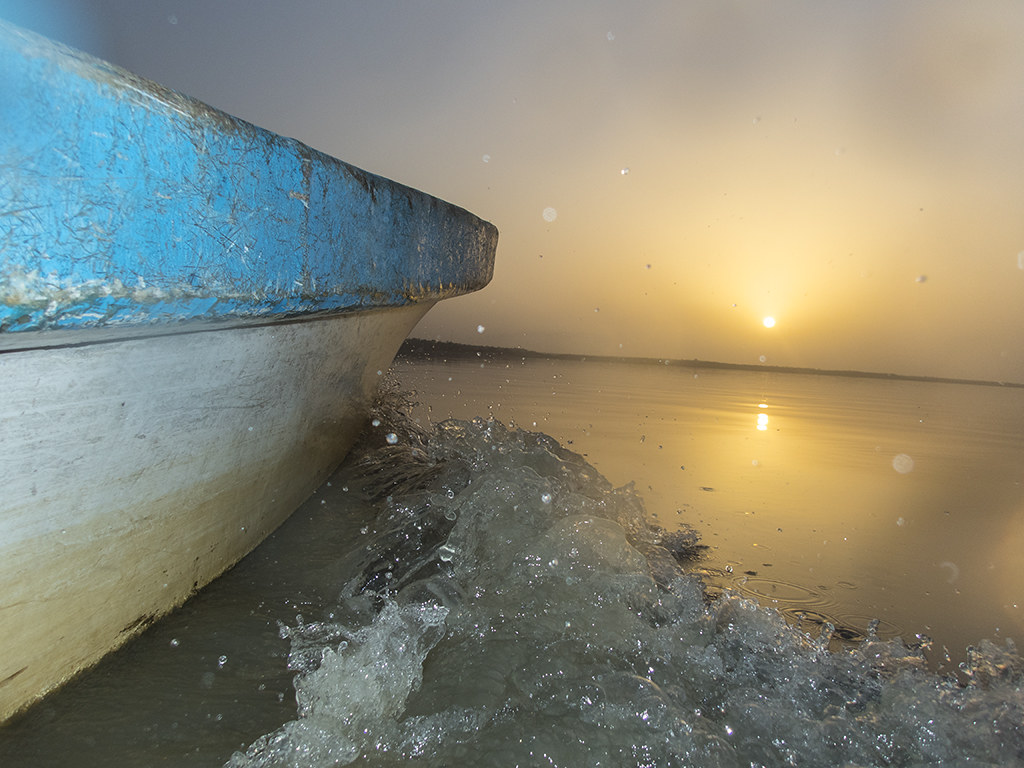 Our last night up river then.
Another iffy meal, some more tepid beer and off to bed.
Our last night up river then.
Another iffy meal, some more tepid beer and off to bed.
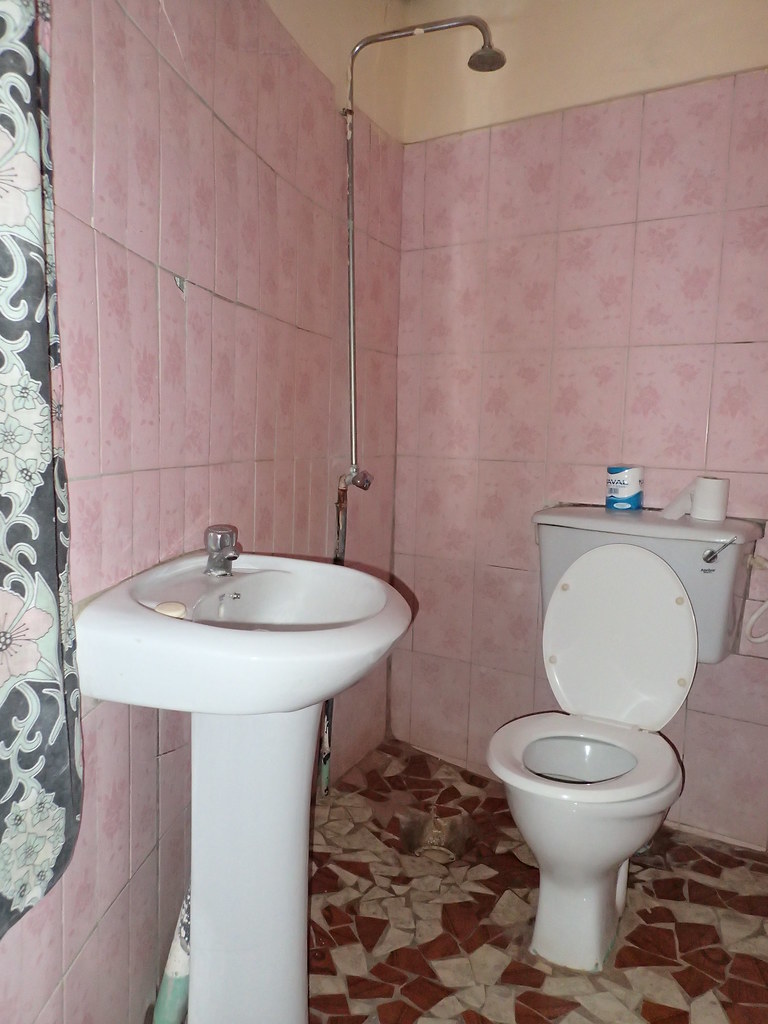 The shower was oddly placed so that you struggled to get under it, especially as there was a big hole where it drained away. However, the good news was there wasn't a ceiling fan in this room, instead a nice quiet stand up one!
The shower was oddly placed so that you struggled to get under it, especially as there was a big hole where it drained away. However, the good news was there wasn't a ceiling fan in this room, instead a nice quiet stand up one!
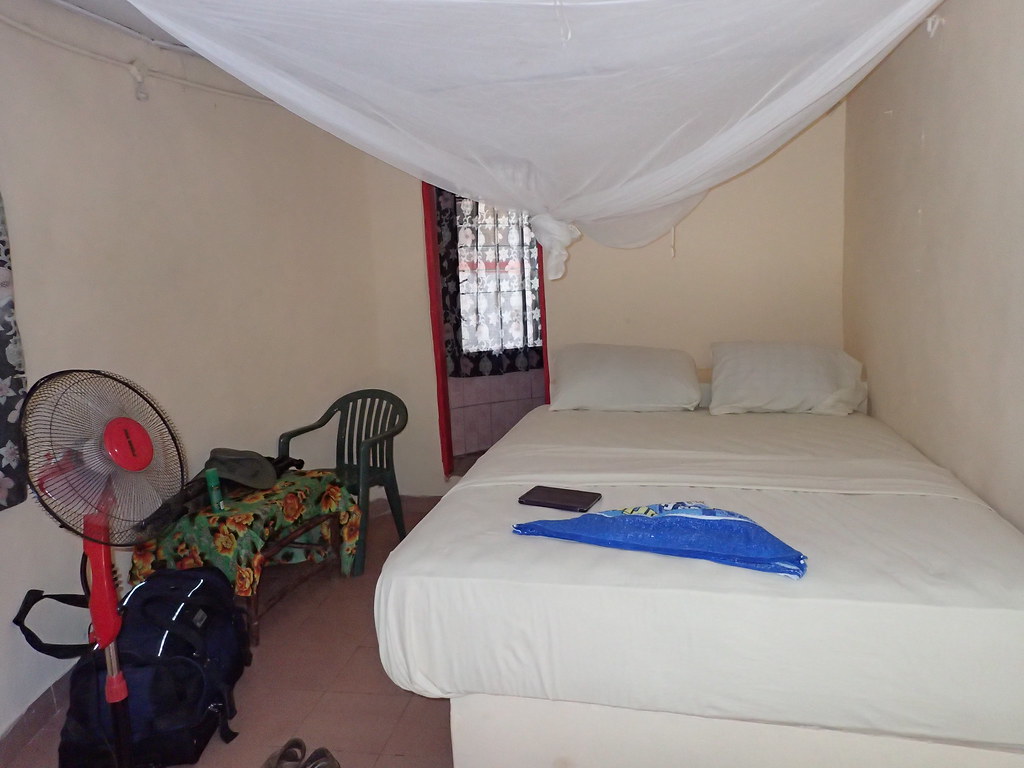 The strange thing is they leave the generators running all night but turn them off at 6.30am leaving you to get up and dressed in the dark!
Still, you can't really complain, from what I can gather it only costs about £12 a night for half board!
At that price, a bargain!
TBC
The strange thing is they leave the generators running all night but turn them off at 6.30am leaving you to get up and dressed in the dark!
Still, you can't really complain, from what I can gather it only costs about £12 a night for half board!
At that price, a bargain!
TBC
Don't misunderstand me, Baobalong Camp is pretty basic but I was loving it. Maybe it was because it was an all new Gambian experience after many previous visits. Maybe it was because I was seeing new birds. I'd already clocked up 3 out of 5 of my top targets, the Ground Hornbill,Egyptian Plover and the Red-throated Bee-eater which when added to the new "lifers"of Spur-winged Goose,Martial Eagle,Red-winged Pytilia and the Exclamatory Paradise Whydah represented a pretty decent haul.
Alan was adding even more new species to his life list but talking of lists we hadn't actually updated ours for a couple of days.
What was happening to my enthusiastic birding mate?
He was morphing from a ticker to a clicker !
He'll deny it of course but he has caught the bug, actually it's worse than a bug, it's a full blown disease. He has a bad case of lens lust and I know he's eyeing up a Canon 400mm f4 DO Mk2 lens. This disease won't kill you, it just wipes out your bank account. "Shrouds don't have pockets" was a regular expression from a recently deceased pal of mine.
Having departed this world prematurely, for him it was the right choice to live life to the full.
Anyway, back to the trip.
We were in with a chance of further increasing the score by firstly returning to Wassau and the sand quarry. Another target the Carmine Bee-eater was to be found there, but only in the morning apparently.
First we went in search of another species, the Black Coucal. We failed on that but added Black-headed Weaver. Another lifer, great start!
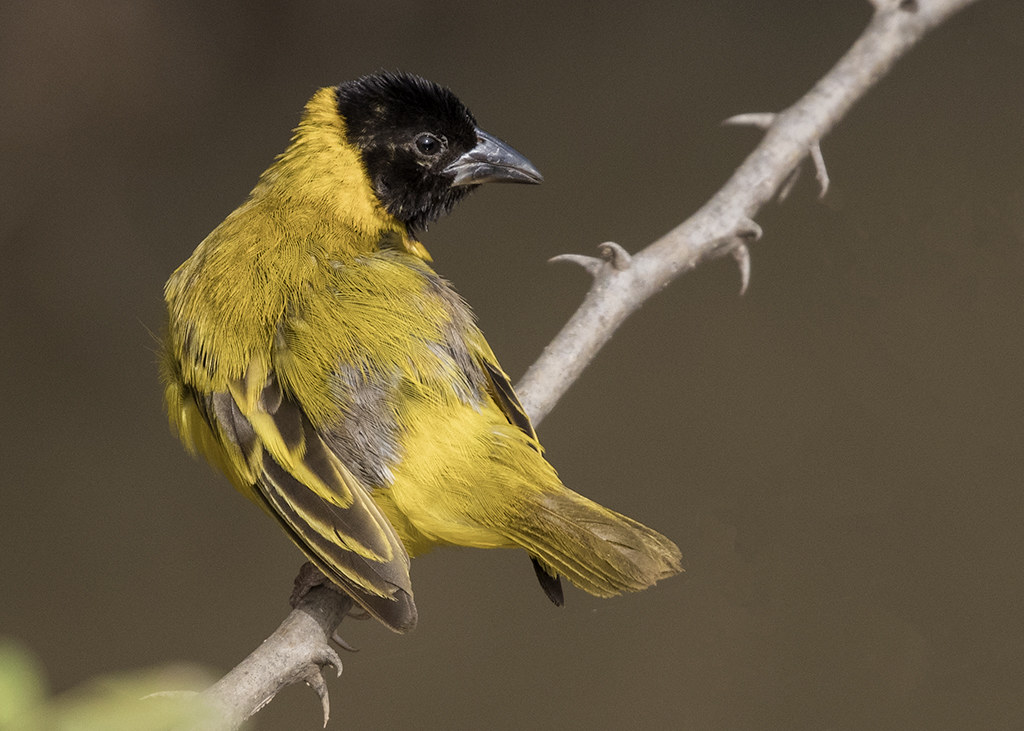 The main event of the morning though was to be the Bee-eaters and luckily they didn't let us down.
There weren't many, maybe a dozen and they were located some way from the Red-throated Bee-eater colony.
One or two were sat in a nearby tree.
The main event of the morning though was to be the Bee-eaters and luckily they didn't let us down.
There weren't many, maybe a dozen and they were located some way from the Red-throated Bee-eater colony.
One or two were sat in a nearby tree.
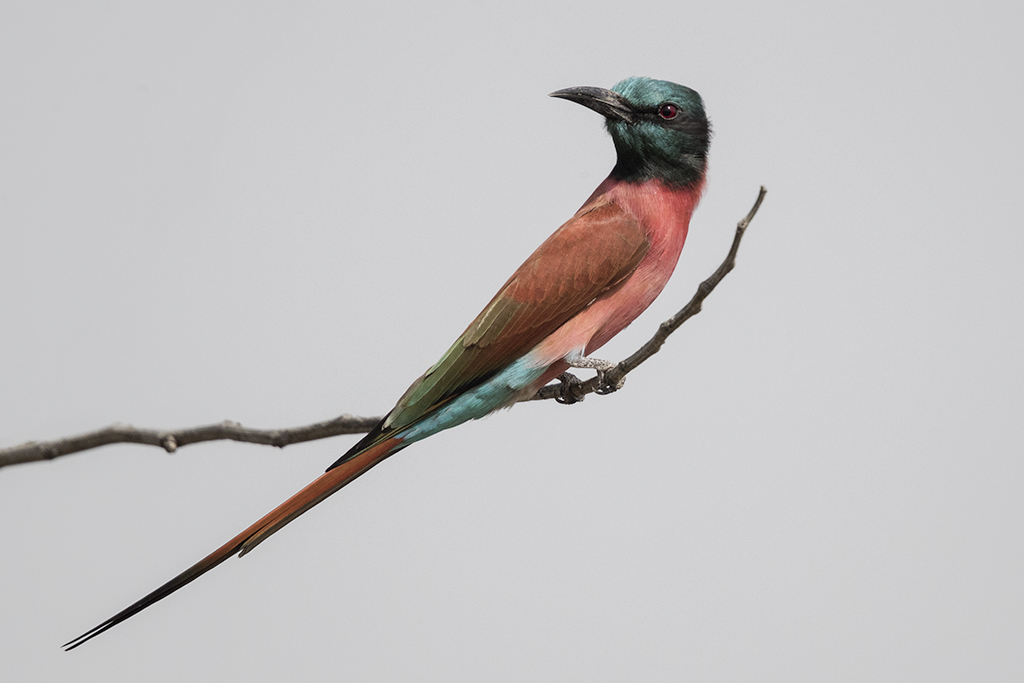 Giving me the best photo opportunities I have had with the species.
They were burning rubbish not far away and the smoke and burning surrounds sends up the insects which is perhaps what the Bee-eaters were waiting for, but they weren't alone. Abyssinian Rollers were flying in in greater numbers than I have ever seen before.
Giving me the best photo opportunities I have had with the species.
They were burning rubbish not far away and the smoke and burning surrounds sends up the insects which is perhaps what the Bee-eaters were waiting for, but they weren't alone. Abyssinian Rollers were flying in in greater numbers than I have ever seen before.
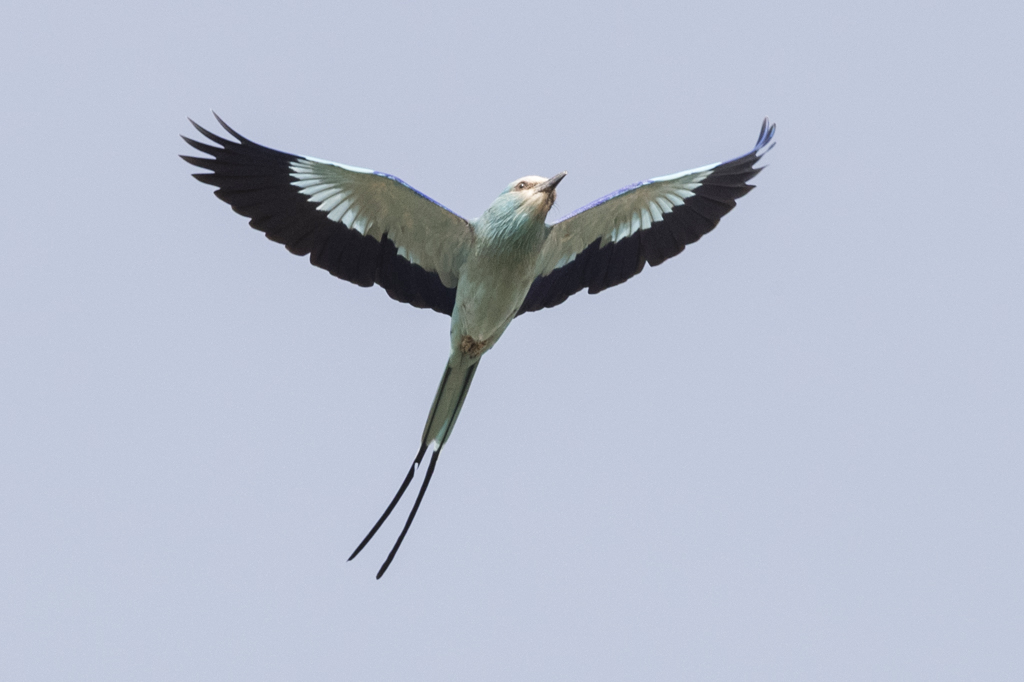 Both were flying too high to get the detailed shots I was after but it was at least something.
Both were flying too high to get the detailed shots I was after but it was at least something.
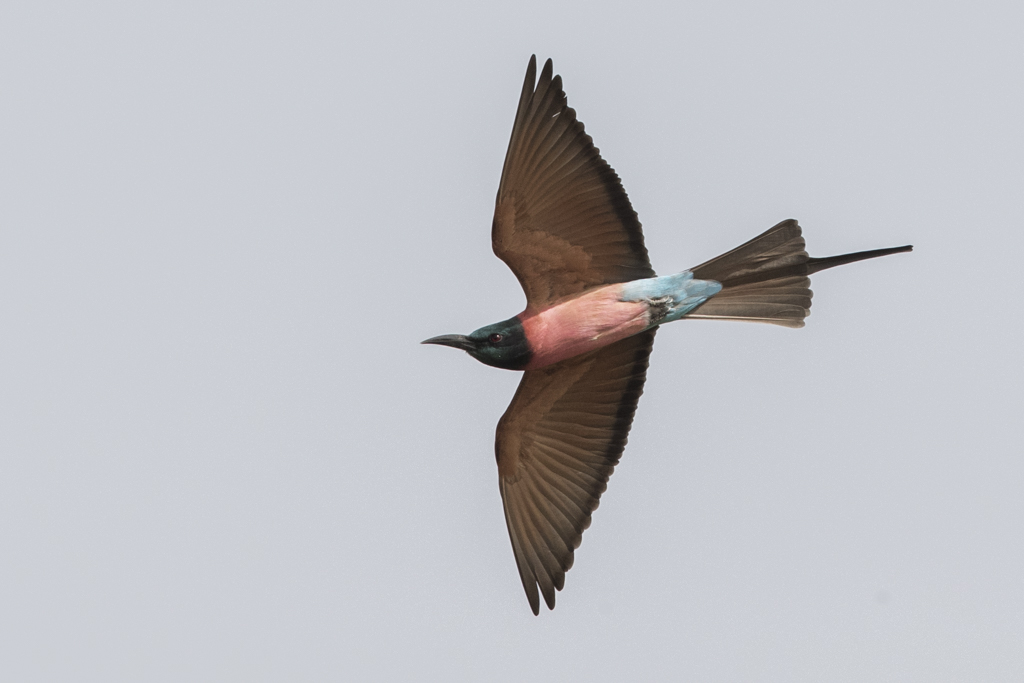 Flying much higher was a Beaudouin's Snake Eagle
Flying much higher was a Beaudouin's Snake Eagle
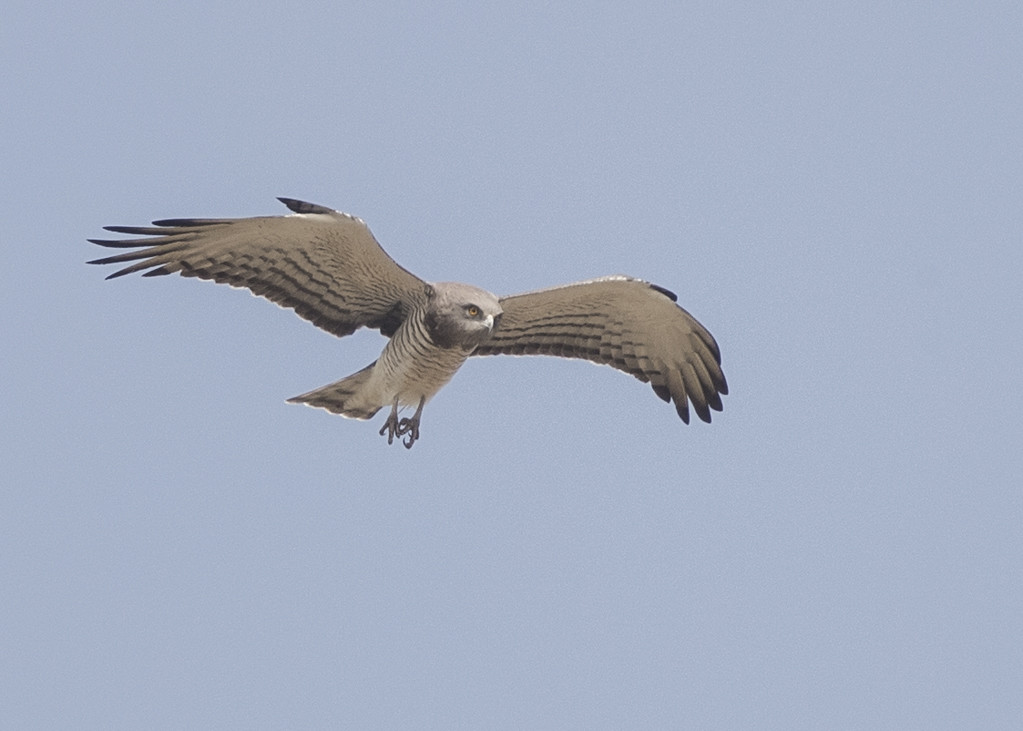 Legs dangling, he looked ready to swoop down on a victim but changed his mind and drifted higher in the thermals.
We moved on the the Red-throated Bee-eater colony.
Legs dangling, he looked ready to swoop down on a victim but changed his mind and drifted higher in the thermals.
We moved on the the Red-throated Bee-eater colony.
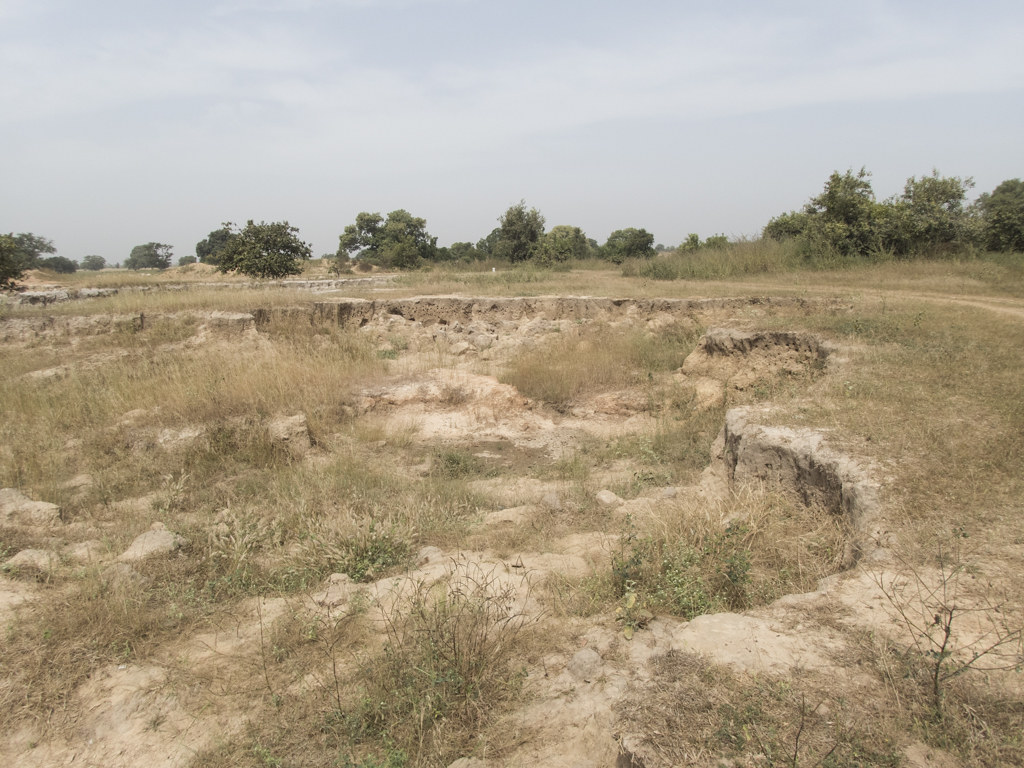 The nest holes were all vacated it seems, they were certainly not feeding youngsters at this time. The weather was a lot brighter than the previous day but the photo opportunities were still rather poor. They were all do distant high in the sky flying or sat in trees.
In fact I had more luck with a fly past Mottled Spinetail.
The nest holes were all vacated it seems, they were certainly not feeding youngsters at this time. The weather was a lot brighter than the previous day but the photo opportunities were still rather poor. They were all do distant high in the sky flying or sat in trees.
In fact I had more luck with a fly past Mottled Spinetail.
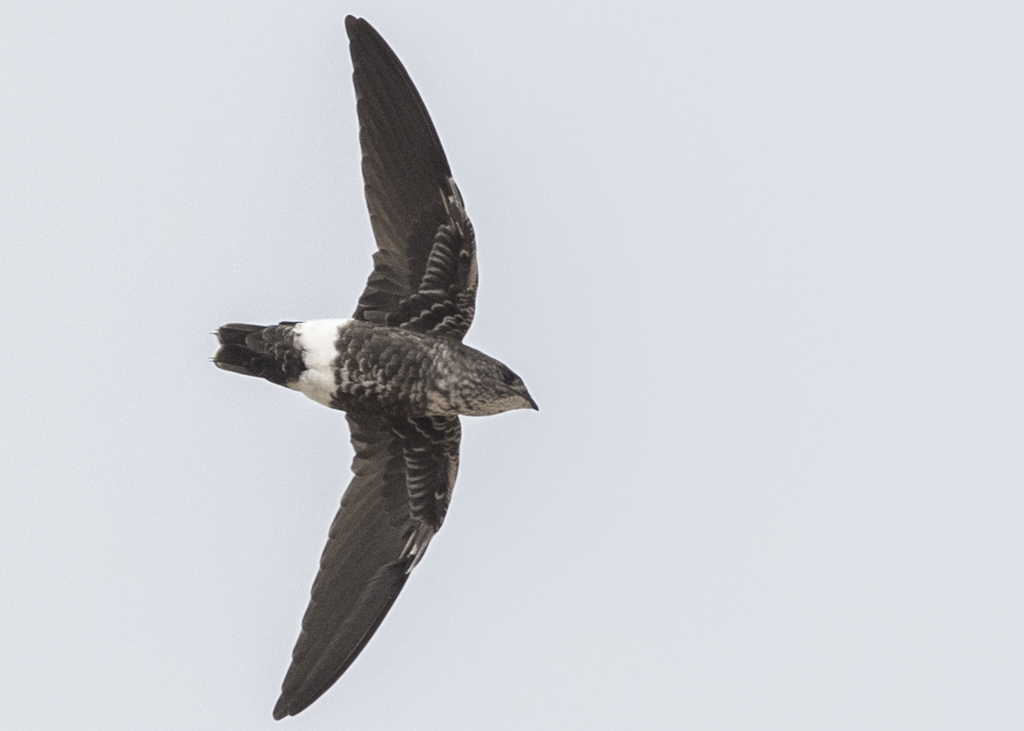 I decided to concentrate on another species I had only just seen for the first time , the Northern Anteater Chat.
I decided to concentrate on another species I had only just seen for the first time , the Northern Anteater Chat.
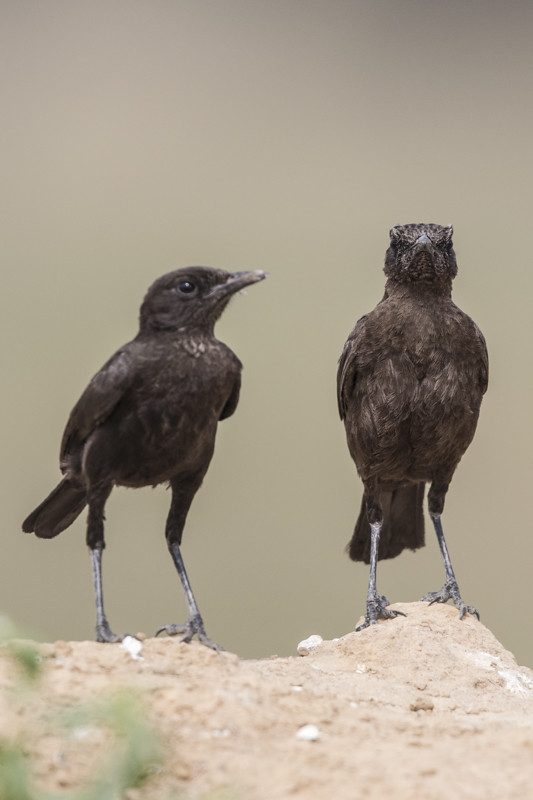 Alan had seen one the previous day, so I was pleased to have caught up with one myself. In fact today there were three of them!
Alan had seen one the previous day, so I was pleased to have caught up with one myself. In fact today there were three of them!
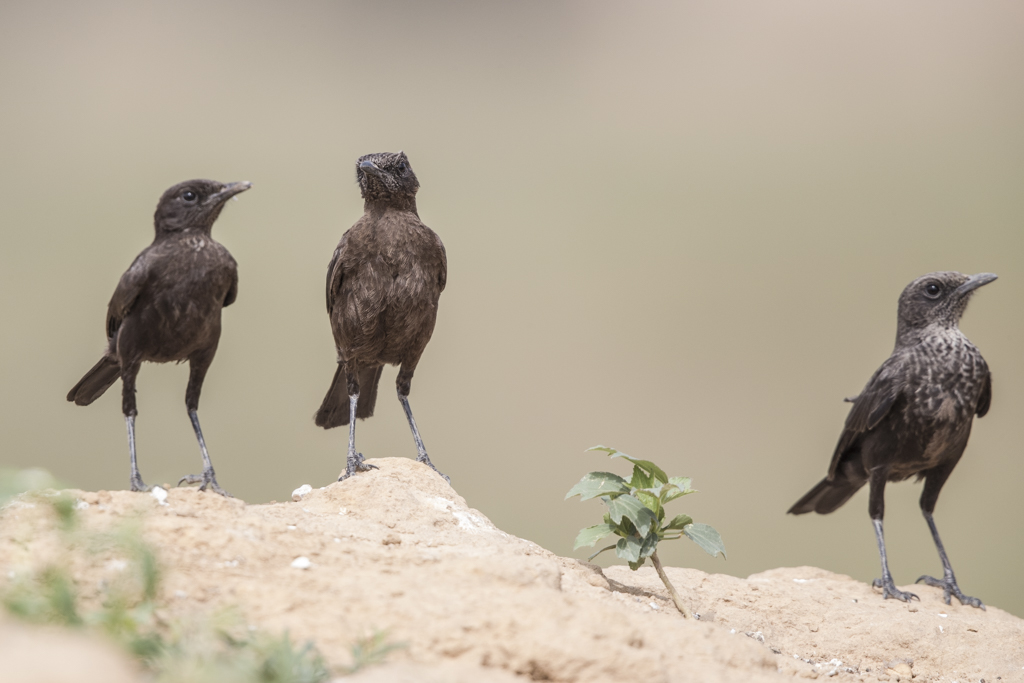 I imagine they are a family.
We spent quite some time in the sand pits, long enough for our driver to make a brew of his favourite green China tea!
I imagine they are a family.
We spent quite some time in the sand pits, long enough for our driver to make a brew of his favourite green China tea!
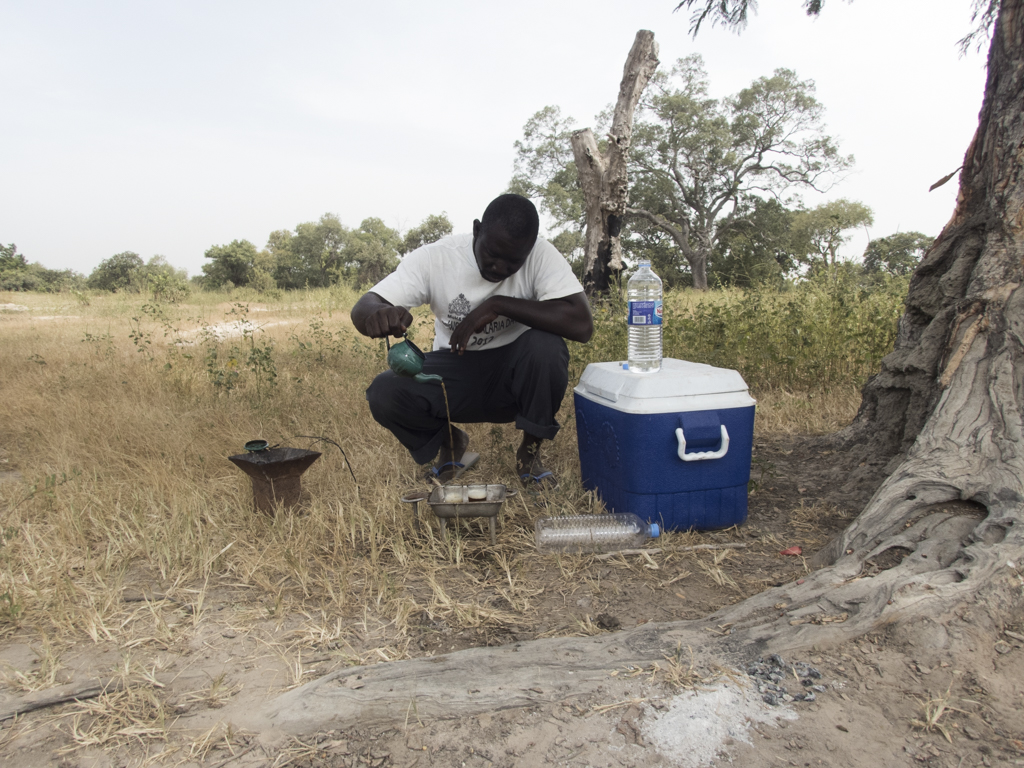 There's a lot more to preparing it than simply pouring water from a boiling kettle too. Very sweet and syrupy it's not my favourite tipple, give me a Julbrew any day!
Having had our fill, and with the sun getting hotter we retreated back towards camp with a quick stop to see the stone circles, a World Heritage Site, on the way.
There's a lot more to preparing it than simply pouring water from a boiling kettle too. Very sweet and syrupy it's not my favourite tipple, give me a Julbrew any day!
Having had our fill, and with the sun getting hotter we retreated back towards camp with a quick stop to see the stone circles, a World Heritage Site, on the way.
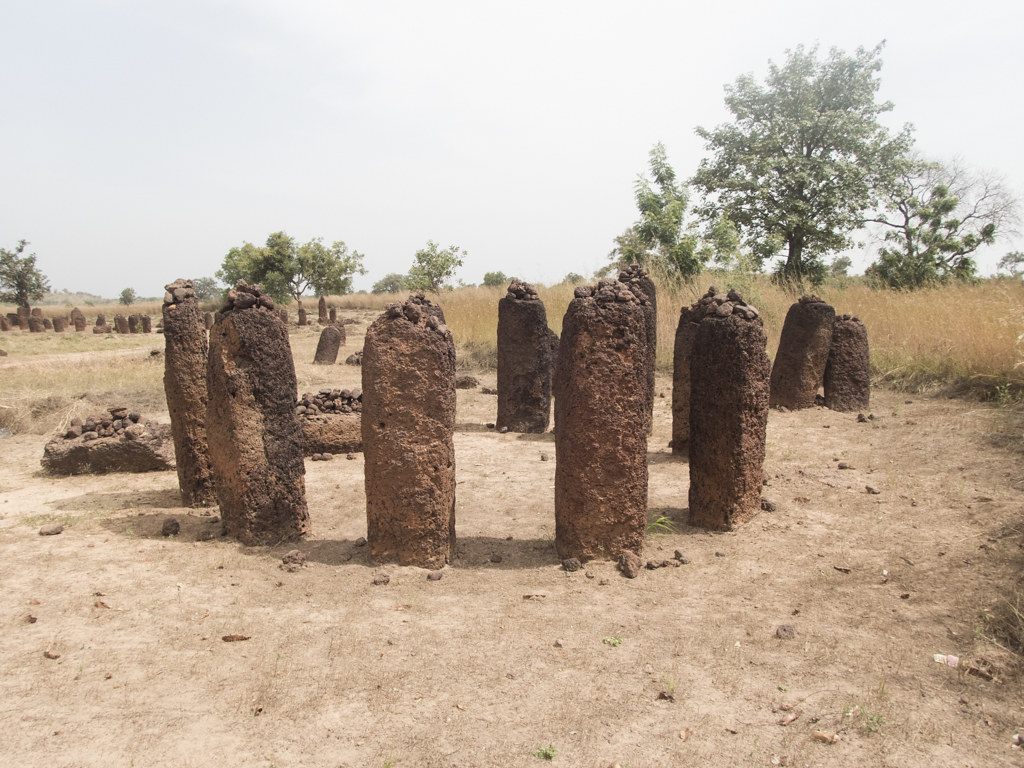 Getting back to camp involves taking the ferry as Janjanbureh is actually on an island in the middle of the River Gambia but there is a bridge conneecting the other side of the island, the way we would be heading back to Tendaba the following day.
Getting back to camp involves taking the ferry as Janjanbureh is actually on an island in the middle of the River Gambia but there is a bridge conneecting the other side of the island, the way we would be heading back to Tendaba the following day.
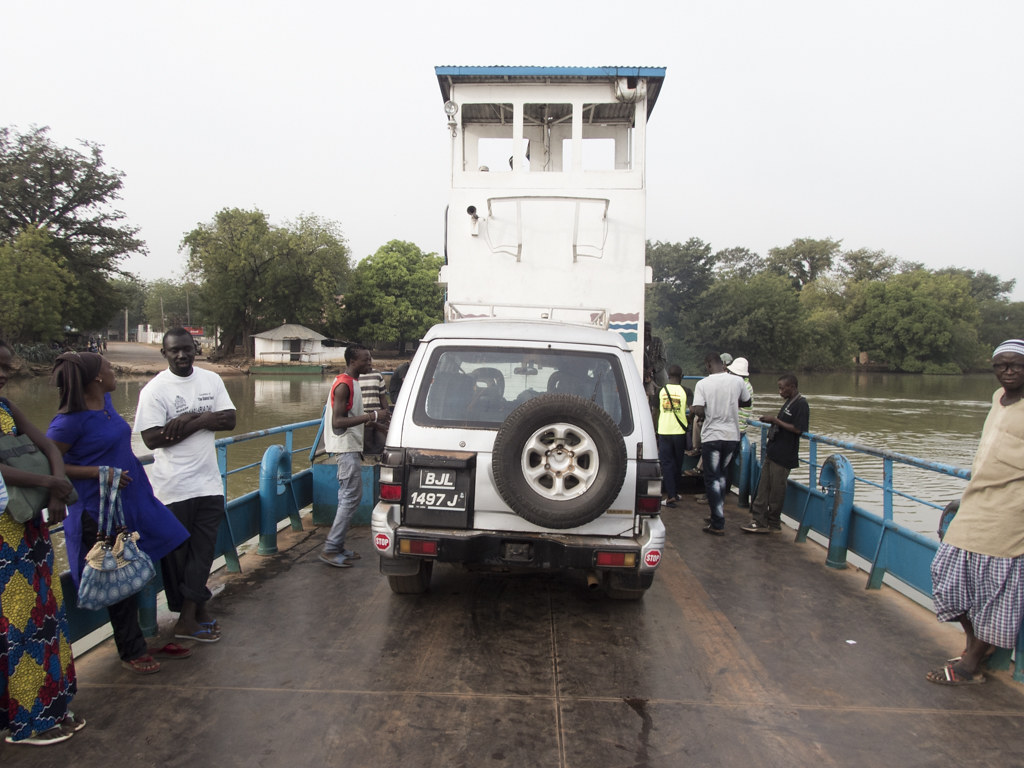 I wasn't exactly elated with my mornings results with the Bee-eaters but there again at least I'd seen them. Another couple who went the following day only saw two Carmine's and they were very distant so I have no right to complain. I must admit though, having photographed European Bee-eaters from hides with purpose built perches well situated I think that they are missing a big opportunity at the quarry. There again it's pretty typical of the approach in The Gambia. Maybe the biggest problem is that none of the guides there actually takes photographs and they need some one experienced that has the time to put a suitable plan in to action.
Anyway, it was siesta time back in camp, well for some anyway. I went off in search of the Owls I had seen the previous evening. It was a long hot walk and my reward was zilch, however, when I was almost back in camp I did get a shot of a Little Green bee-eater that was better than anything I had seen earlier... you get them in the quarry too.
I wasn't exactly elated with my mornings results with the Bee-eaters but there again at least I'd seen them. Another couple who went the following day only saw two Carmine's and they were very distant so I have no right to complain. I must admit though, having photographed European Bee-eaters from hides with purpose built perches well situated I think that they are missing a big opportunity at the quarry. There again it's pretty typical of the approach in The Gambia. Maybe the biggest problem is that none of the guides there actually takes photographs and they need some one experienced that has the time to put a suitable plan in to action.
Anyway, it was siesta time back in camp, well for some anyway. I went off in search of the Owls I had seen the previous evening. It was a long hot walk and my reward was zilch, however, when I was almost back in camp I did get a shot of a Little Green bee-eater that was better than anything I had seen earlier... you get them in the quarry too.
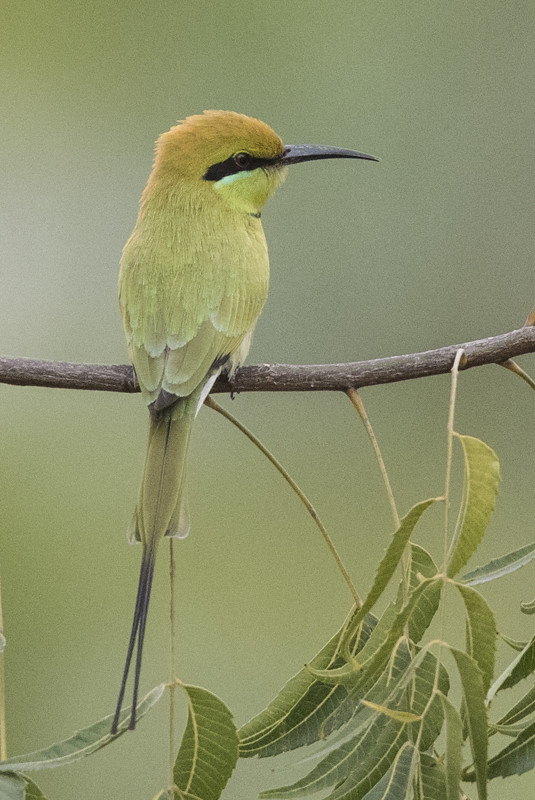 We all met at the river bank in camp at 3.30pm for the next little escapade, another boat trip. The small boat was big enough for 6-8 people but there were just four of us including the boatman and our guide. It took the boatman 10 minutes to get the engine started but we eventually moved off only to pull in to shore about 100 yds down river.
Why ? To refuel of course !
We then had problems getting the engine started again. This was getting a bit frustrating as we would be missing the best light of the day soon. 30 minutes had already passed by and we had gone nowhere. Once again, so typical Gambia. This should have been done before picking us up, the boatman had been sat around doing nothing while waiting for us.
Finally on our way we passed by a few familiar species sat in branches over hanging the river. The engine stalled a few times, we inhaled lots of fumes every time it was restarted. However, we were getting really annoyed when we sailed past what was a first for both of us, a Pygmy Goose.
Slow down I cried, the engine was going flat out to stop it stalling I guess.
By the time we turned around we had gone well past it, I had grabbed a couple of shots but over exposed them far too much.
We all met at the river bank in camp at 3.30pm for the next little escapade, another boat trip. The small boat was big enough for 6-8 people but there were just four of us including the boatman and our guide. It took the boatman 10 minutes to get the engine started but we eventually moved off only to pull in to shore about 100 yds down river.
Why ? To refuel of course !
We then had problems getting the engine started again. This was getting a bit frustrating as we would be missing the best light of the day soon. 30 minutes had already passed by and we had gone nowhere. Once again, so typical Gambia. This should have been done before picking us up, the boatman had been sat around doing nothing while waiting for us.
Finally on our way we passed by a few familiar species sat in branches over hanging the river. The engine stalled a few times, we inhaled lots of fumes every time it was restarted. However, we were getting really annoyed when we sailed past what was a first for both of us, a Pygmy Goose.
Slow down I cried, the engine was going flat out to stop it stalling I guess.
By the time we turned around we had gone well past it, I had grabbed a couple of shots but over exposed them far too much.
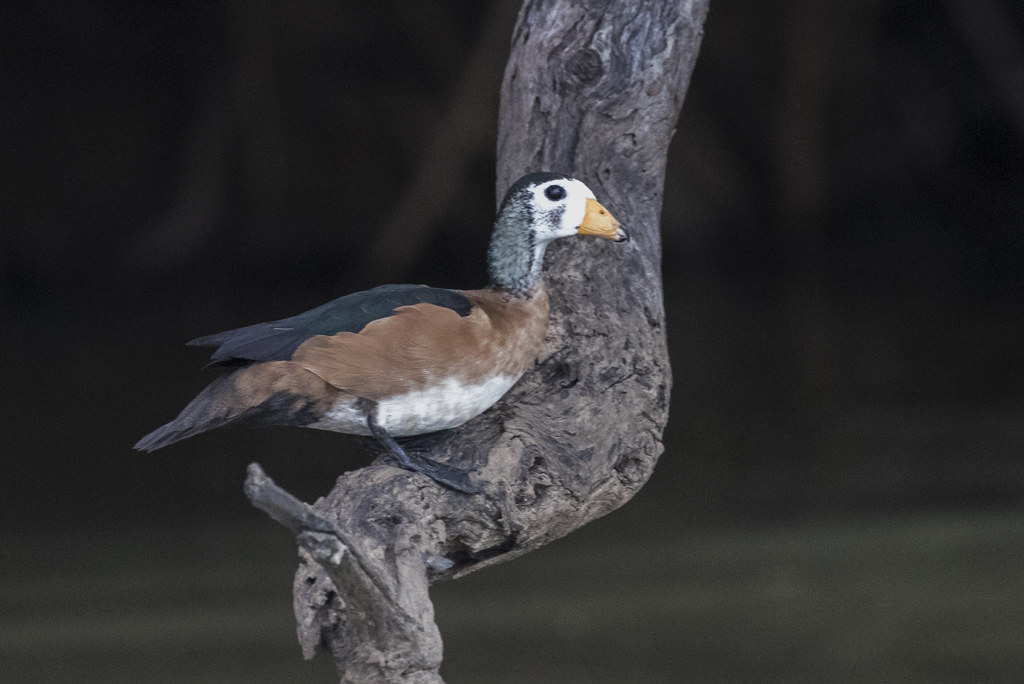 We requested another drive past which the boatman attempted to do but stalled the boat in the process. Too far away for a decent shot we could only look on as the goose got fed up of the disturbance from the coughing , spluttering boat.
Breakdowns were a feature of the trip. That and the driver spending more time looking at the cigarette he was rolling than keeping an eye out for something to see.
We did manage some half decent views though.
African Fish Eagle,
We requested another drive past which the boatman attempted to do but stalled the boat in the process. Too far away for a decent shot we could only look on as the goose got fed up of the disturbance from the coughing , spluttering boat.
Breakdowns were a feature of the trip. That and the driver spending more time looking at the cigarette he was rolling than keeping an eye out for something to see.
We did manage some half decent views though.
African Fish Eagle,
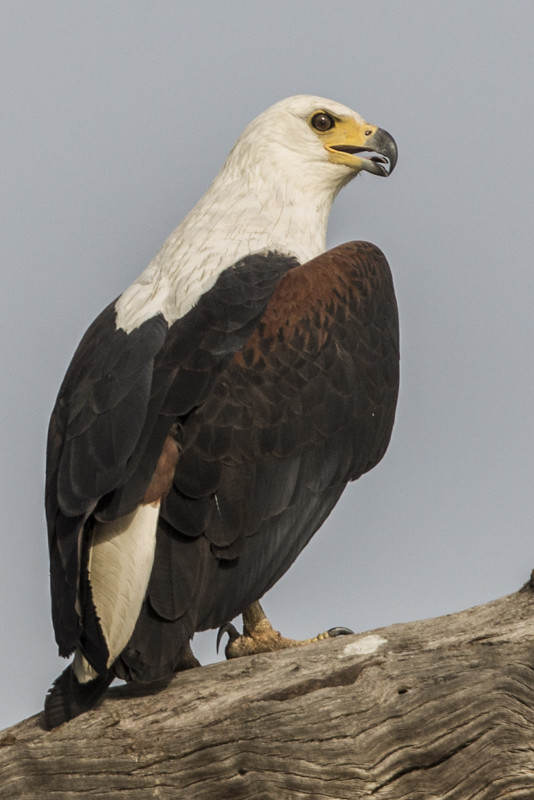 Palm Nut Vulture
Palm Nut Vulture
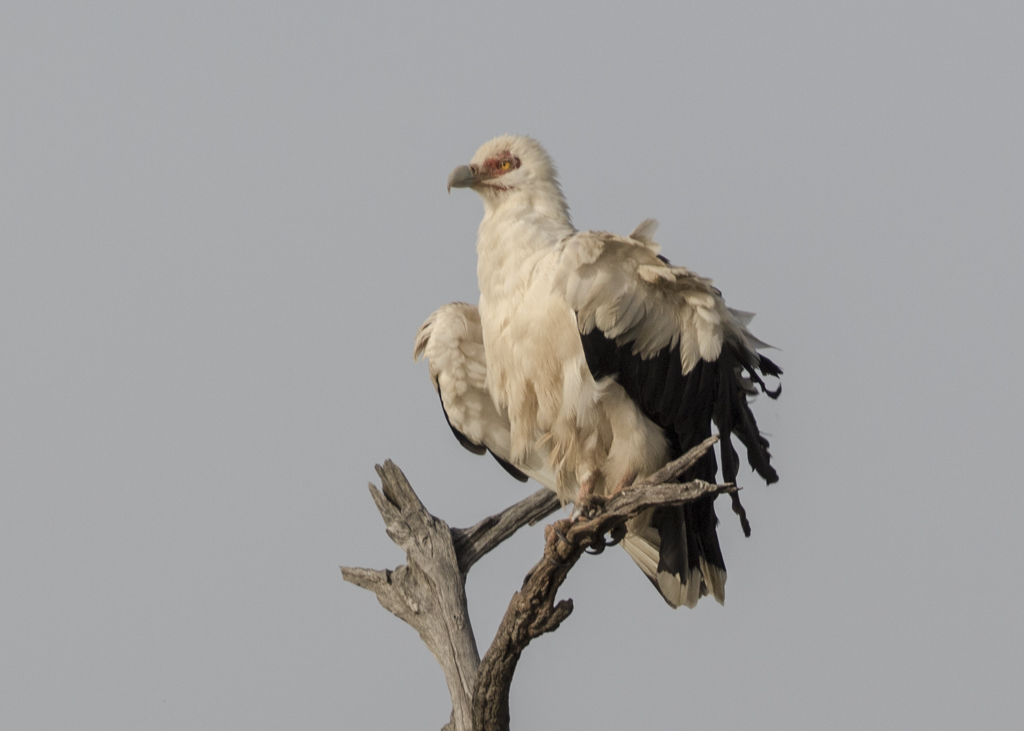 Black-crowned Night Heron
Black-crowned Night Heron
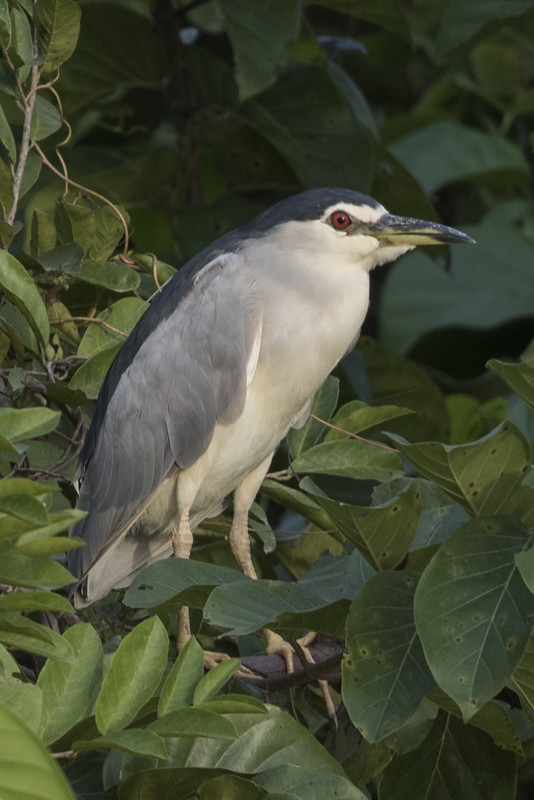 but best of all, another first for me, Swamp Flycatcher.
but best of all, another first for me, Swamp Flycatcher.
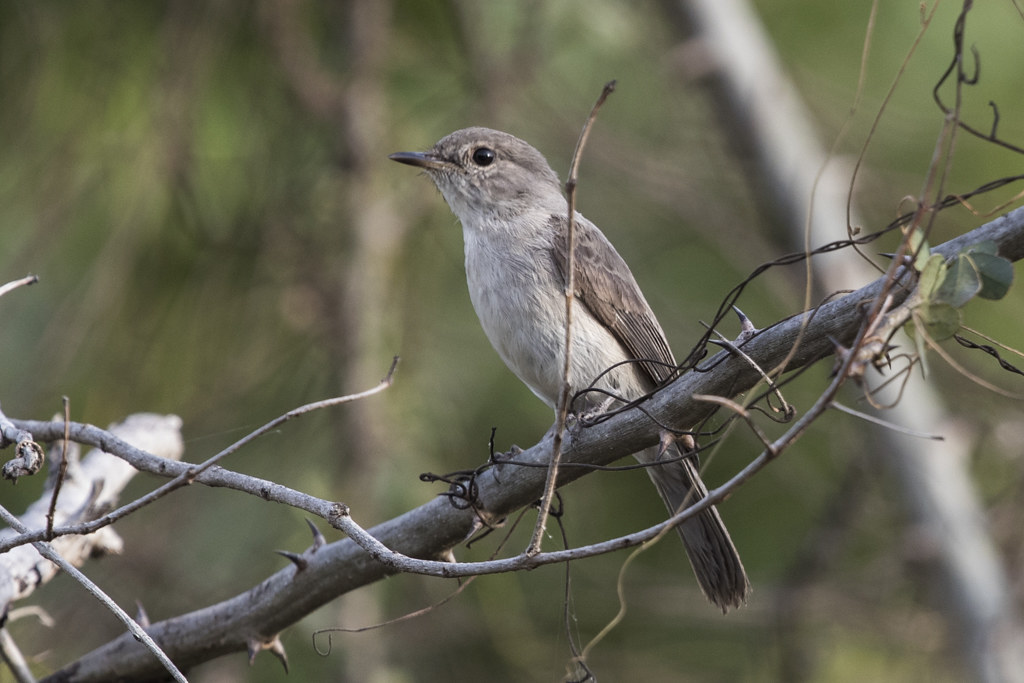
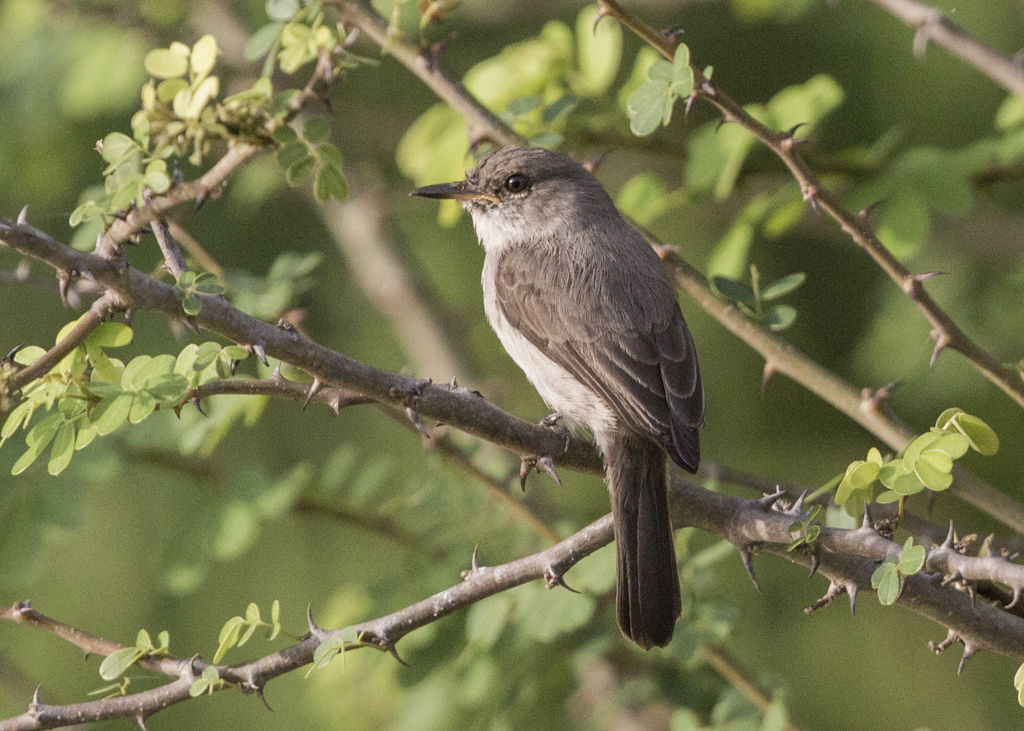 We did get views of both Grey-headed and Woodland Kingfishers but the highly desired Shining Blue Kingfisher stayed well out of sight as did my only unseen Top 5 target... the African Finfoot.
Still, I would have settled for 4/5 before we set off so I was still happy, well with the birds anyway.
The boat was something else.
On the way back we put in on the opposite bank where you catch the ferry and our man disappeared off to buy some new spark plugs. Hey, ho, the boat now started first time. Why hadn't he done all this in the first place? To make matters worse he actually had the nerve to ask Alan, who was last off the boat,for a tip. Alan being Mr Nice guy obliged.
Oh well, it was only a few pounds, didn't exactly break the bank but it doesn't encourage better service for those who follow either.
Typical Gambia
TBC.
We did get views of both Grey-headed and Woodland Kingfishers but the highly desired Shining Blue Kingfisher stayed well out of sight as did my only unseen Top 5 target... the African Finfoot.
Still, I would have settled for 4/5 before we set off so I was still happy, well with the birds anyway.
The boat was something else.
On the way back we put in on the opposite bank where you catch the ferry and our man disappeared off to buy some new spark plugs. Hey, ho, the boat now started first time. Why hadn't he done all this in the first place? To make matters worse he actually had the nerve to ask Alan, who was last off the boat,for a tip. Alan being Mr Nice guy obliged.
Oh well, it was only a few pounds, didn't exactly break the bank but it doesn't encourage better service for those who follow either.
Typical Gambia
TBC.





















































